THE YAGANAGI FAMILY OF BANGALORE
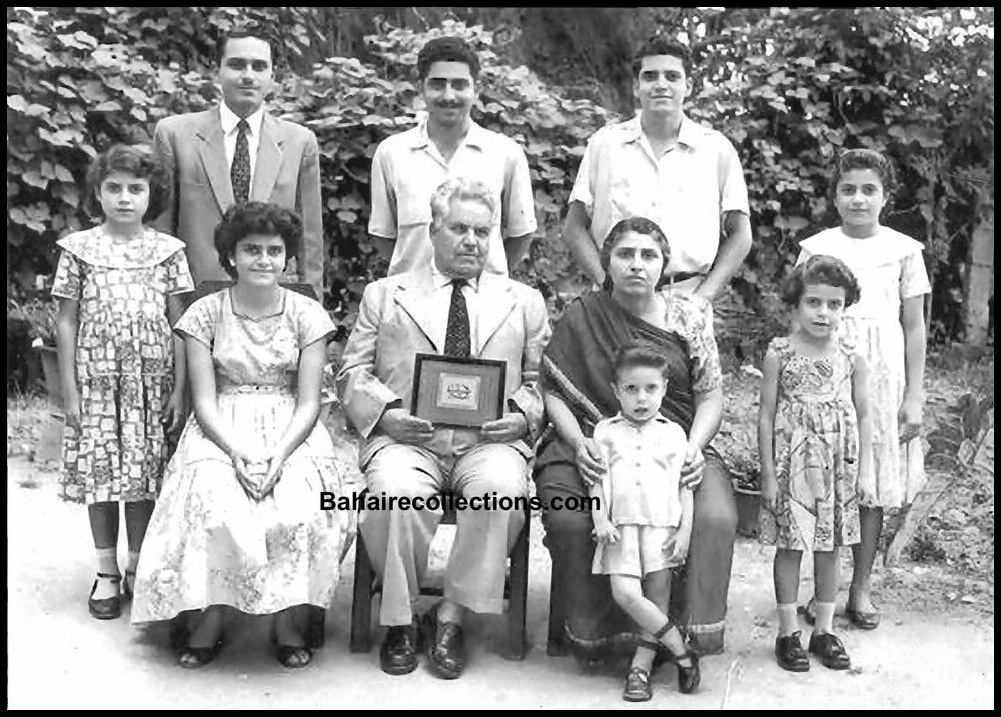
THE YAGANAGI FAMILY
This story is to pay tribute to my parents who were the first pioneers to South India and established the first Local Spiritual Assembly in Bangalore City. They persevered at their post for nearly half a century and came to be regarded as the spiritual parents of that region. The eight children of this couple too arose to pioneer to several parts of the world at some point in their lives and are therefore known as a family of pioneers. This is a humble effort to present some of the salient services that my parents rendered at a time when the Faith was taking root in South India.
My Father Soroosh Forood Yaganagi
My father, Soroosh Forood Yaganagi, affectionately known as “Aghajan”, was born into a Zoroastrian family in the village of Ghasemabad in the province of Yazd in Iran on 14 February 1902. His father was Forood, and mother Mehrbano. He had an older sister, Golbano, and an older brother, Isfandiar. He left Iran when he was 17 years old to go to India for business reasons.
Arriving in Bombay in about 1919, my father went to Poona (Pune) to join his father or my grandfather, Forood Shariar, and his older brother or my uncle, Isfandiar Forood, who was ten years older than him. Both my grandfather and uncle had come to India from Iran a few years earlier. My grandfather never helped his two sons while in Pune. It was my uncle Isfandiar who took care of my father when he first arrived in Pune by giving him a job in his small restaurant.
My father and uncle Isfandiar complemented each other, so their business partnership was a happy and prosperous one. Both brothers shared an intense love for each other throughout their lives. After a short time of working together, my father moved on and worked with a person who owned a toddy business. Toddy is a sap obtained from a palm tree which was fermented to produce an alcoholic beverage. Both brothers collected enough money in a couple of years to jointly own the Yazdani Restaurant in Pune.
BIRTH OF THE YAGANAGI FAMILY
It needs to be mentioned that the last names of my father and my uncle Isfandiar were originally “Forood”, which was their father’s first name. In the early 1930s, government officials from all Iranian consulates ordered that all Iranians could not keep their father’s first name as their last name. With that directive, all Iranians had to get a new last name. The name Farood was then dropped. This was around the time when my father and his brother had become Bahá’ís. So, they decided to take the last name “Yaganagi”, which in Farsi means “Unity”. Unity being the basic tenet of the Bahá’í Faith, and it fit very well in this new life’s journey that they were going to undertake.
SEEKING THE PROMISED ONE
In Iran, the followers of Islam gave the Zoroastrians a very hard time by insulting them, spitting on their faces, and throwing junk into their yards. But my father and uncle waited for the advent of the World Savior, the S̲h̲áh-Bahram, as promised in the sacred books of the Zoroastrian Faith. While in Iran, they had heard about the Bahá’í Faith. But what they had heard was all kinds of false accusations and rumors about the Bahá’ís. They had intense hatred towards the Bahá’ís. For this reason, they did not go into serious investigation of the Bahá’í Faith.
There was a storekeeper in Poona by the name of Zainal Abidin Mahalati whose family was from a Zoroastrian background. But they did not know that Zainal Abidin was a Bahá’í. He was a regular customer at the Yazdani Restaurant in Pune, which was jointly owned by my father and uncle. When Zainal Abidin saw that both brothers were keen on learning Farsi from him, he came to the Yazdani Restaurant from 2:00 pm to 3:00 pm every weekday. These classes were held in a room in the Yazdani Restaurant. Zainal Abidin read to them from the Mathnawi, written by Jalāl al-Dīn Muḥammad Rūmī, the renowned mystic poet of Persia, and passages from the Holy Quran, in which references were made to the return of a Messenger of God. Zainal Abidin would go to his store in the market after classes and return at 6:00 pm to say goodbye for the day before returning to his home.
My father recounted this story on numerous occasions of how both brothers became Bahá’ís. He said that he and his brother had been searching for over seven years for The S̲h̲áh-Bahram. They both had strong feelings that the Promised Savior had already appeared, but did not know where to find Him.
My father mentioned that when they went to the Fire Temple in Pune, where the priests would burn ordinary wood rather than the sandalwood they took there. On questing that, my father and uncle were excommunicated from the Zoroastrian Faith and were not allowed to enter the Fire Temple ever again. This led them to search for the promised S̲h̲áh-Bahram elsewhere. My uncle Isfandiar showed his daughter Monira a tree in a park in Pune under which my father, and he would always sit and weep and beg God to help them find the Promised S̲h̲áh-Bahram.
One night, my uncle had a dream that he would find out about the World Savior the next day. My father also had an amazing experience the same night. He saw a bright light flooding his whole room in a room in the restaurant in which he lived. At first, he thought it came from some very brilliant object from the sky. He looked outside and saw that there was no light except the light from the moon and the twinkling stars. Yet surprisingly, his whole room was flooded with this bright light. He looked everywhere but could not figure out where this bright light was coming from. He finally got exhausted and went to sleep. When he went back to sleep, he dreamed that there were two fish swimming in muddy water, and then suddenly they were swimming out into crystal clear water. In the morning, when he went into the front of the restaurant, he wondered why the furniture and other items in the room were moved around! He knew that no one had broken into the restaurant or his room.
My uncle mentioned his strong feelings about the imminent appearance of the World Savior to my father, and said, “God willing, we both will know the truth today.”
Now, both the brothers were very excited and were anxiously waiting for 2:00 pm. Zainal Abidin arrived punctually at 2:00 pm as he always did. They went to the room to study Farsi. When he read the Mathnavi, Zainal Abidin would explain it to them very well. But he evaded some other verses. On that day, he read a passage saying that “a person had slept for 1,000 years and when he woke up he wanted to use the coins from his pocket, but the police stopped him and asked him from where he got those coins. He answered that these coins are not recent… they were from a long time ago.” When they asked him what this verse meant, Zainal Abidin told them they would find the meaning on their own. It was 3:00 pm and Zainal Abidin got up and left.
As usual, he came back at 6:00 pm to say goodbye on the way to his home. The brothers paid off the carriage driver and told him to leave but retained Zainal Abidin. They were not going to let Zainal Abidin walk away without telling them who this World Savior was. The brothers took a knife into the room and locked the door. They insisted that he tell them the meaning of the verse or else he was not going to leave the room alive. Their insistence was based on the strong feeling my uncle had on the return of the S̲h̲áh-Bahrám and the dream my father had the previous day. Their teacher realized that he could no longer hold the truth from them! Zainal Abidin was reluctant to tell them that Bahá’u’lláh was the Promised One, the Universal Messenger of God, The S̲h̲áh-Bahrám, for today, because these two brothers had not accepted the Bahá’í Faith when they had heard about it in Iran. But now he told them that the Universal Messenger of God for today was “Bahá’u’lláh”, the prophet founder of the Bahá’í Faith, and indicated to them that the S̲h̲áh-Bahram had already come. As soon as Zainal Abidin gave this answer, they fell to the ground in shock and shame, and even fainted. When they became conscious, they were so sad and wept bitterly with shame for not having investigated the Bahá’í Faith when they were in Iran. Both immediately accepted Bahá’u’lláh and became Bahá’ís.
Now, when their father heard that they had become Bahá’ís, he became very angry. He went to the Yazdani Restaurant and threw all the money from the cash register and other things onto the street. He shouted that they were going to hell for having left their Zoroastrian Faith to become Bahá’ís. He told the passers-by to take all the things that he had thrown on the street as they belonged to “Kaffirs” or non-believers.
My Mother Firoozeh Bidenjeri Yaganagi
My mother, Firoozeh, was born February 14, 1919, in the village of Maryamabad, in Yazd, Iran. Her father was Mehraban and mother Gowhar. After her mother passed away, her father married Kharman. My mother came to India when she was 14 years old with her father Mehraban Bidenjeri, and younger brother Keikhosrow for medical reasons. She lived with a very kind Parsee family in Bombay for 2 years. Her father had accepted the Bahá’í Faith before leaving Iran.
My mother had to follow the rituals of the Zoroastrian Faith when she lived with the family in Bombay, but secretly said her Bahá’í prayers. She had learned these prayers from her Bahá’í neighbor in Iran when they met at the public well to get water together. There was also a Bahá’í family on the same floor in the building in Bombay and the children shared with her each week what they had studied at the Bahá’í children’s classes. My parents got married on 21 April 1935, which was the first Bahá’í marriage in Pune.
PIONEERING TO BANGALORE
The beloved Guardian, Shoghi Effendi, asked believers to move to other parts of India under the Six-Year Plan. That letter was read at the Nineteen-Day Feast in Pune, in which the Guardian urged the Iranian Bahá’ís especially to go pioneering and not get saturated in Pune and Bombay. My parents, who were touched by this call, moved out of Pune to Bangalore city in Karnataka State with their three sons – Anayat, Farrage and Faiz. They became the first Bahá’í pioneers of South India. They arrived in Bangalore on October 1, 1941.
The Guardian was very pleased with my parents. A letter written on his behalf to the National Spiritual Assembly of India, dated 27 December 1941, reads, “He read with great interest the report of the progress of the teaching work in Kashmir, as well as the wonderful news of the departure of Mr. Yaganagi and family in Bangalore…”
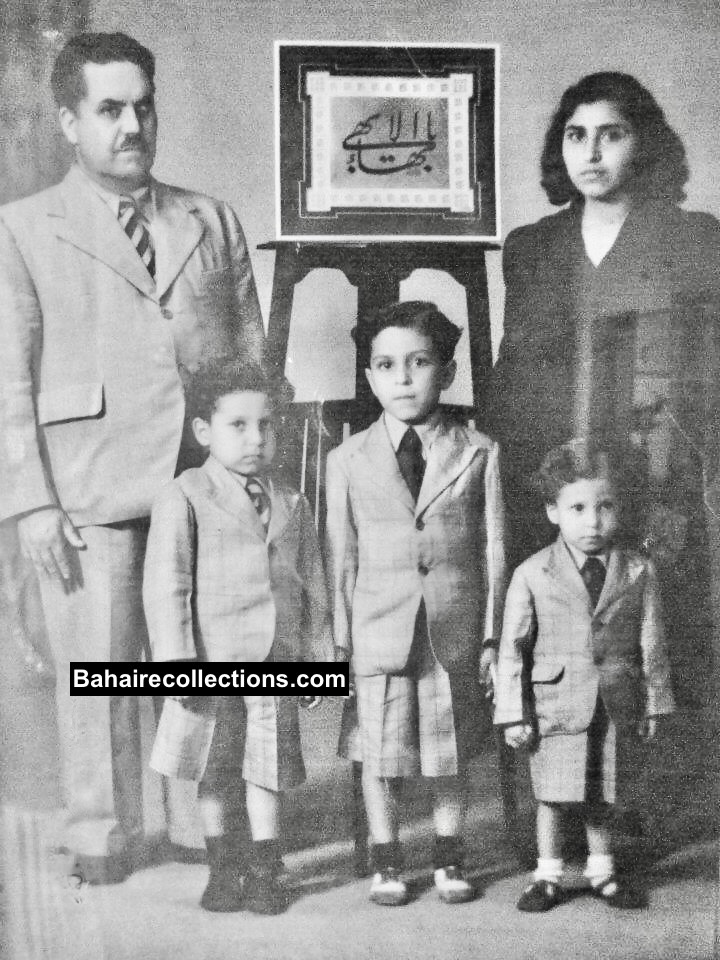
A 1942 photo in Bangalore. My father, and my mother Firoozeh at the back with my brothers L- R: Farrage, Anayat, and Faiz.
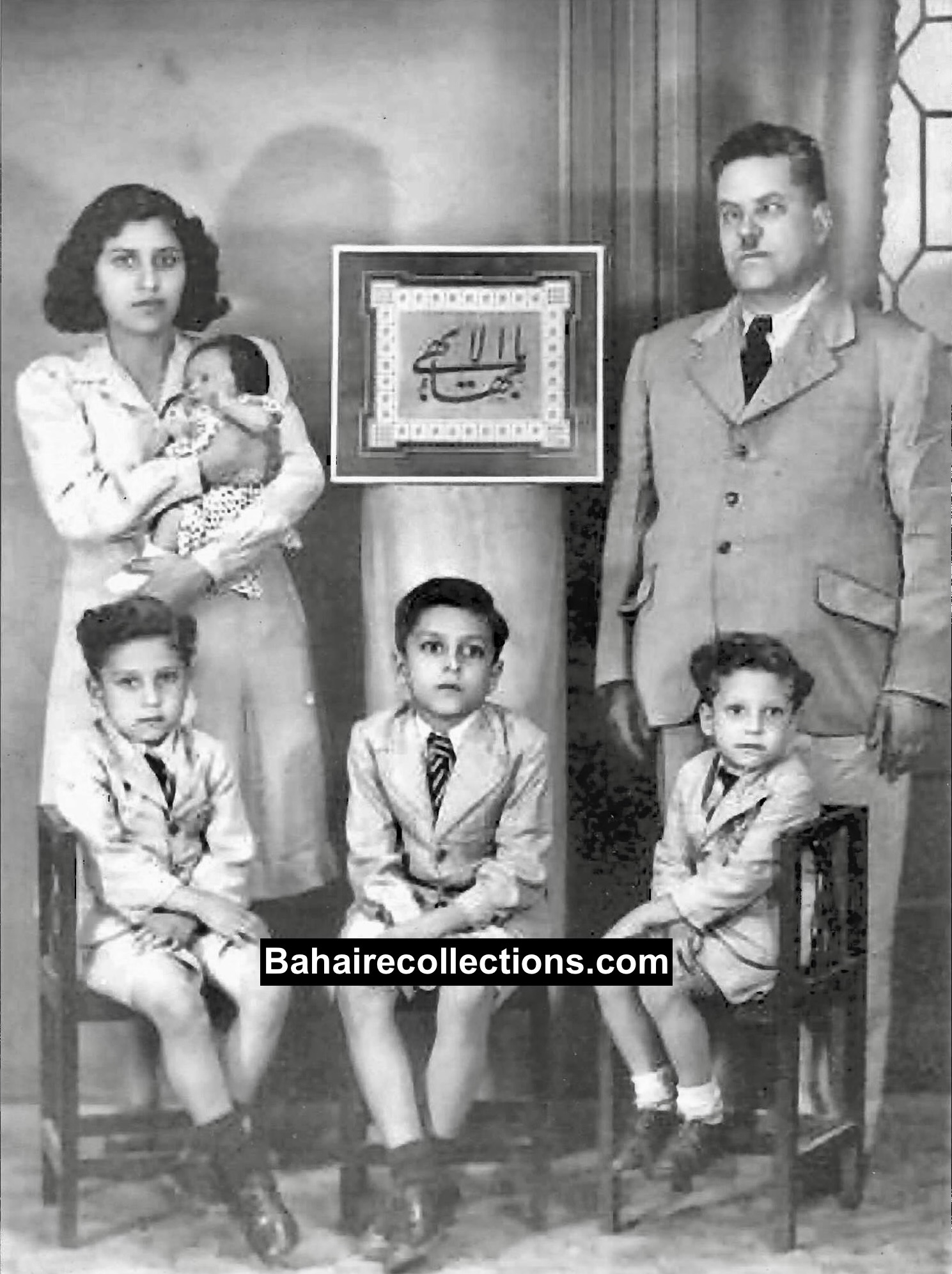
A 1944 photo in Bangalore. Standing L-R: My mother Firoozeh carrying Tuba, My father Soroosh Yaganagi. Sitting L to R: my brothers Farrage, Anayat and Faiz.
In Bangalore, my father owned the Mubarak Hotel, which was opposite the Russell Market. The Mubarak Hotel was popularly known as a Bahá’í restaurant.
FIRST SPIRITUAL ASSEMBLY
As soon as they landed in Bangalore, it was not easy to find a good house, as the World War was still in progress. They established their residence in a few places in Bangalore. They initially lived in a small house in the Sindhi Colony and then wanted to move into a bigger house so that it could serve the needs of the Faith. So, they moved to a house on Palm Road in Frazer Town. This residence on Palm Road was also the Bahá’í Centre for Bangalore. The beloved Guardian had sent my father a letter to tell him to establish the first Local Spiritual Assembly of the Bahá’ís of Bangalore by April 21, 1942. At the time of receiving the letter there were only two Bahá’ís in Bangalore — my parents. Since it was a directive from the Guardian, my father lost no time in achieving the goal set for him. My parents had brought along some Bahá’í pamphlets and books from Pune, and they used them to teach the local people.
One day my father was walking along the Palm Road with some pamphlets in his pocket with the desire of teaching the Faith. At that time, he could not speak any of the South Indian languages. He spoke Farsi, Urdu and very little English. As he saw a room with people having a meeting, he knocked on the door and went in. With the little English that my father knew, he introduced himself and informed them about the Bahá’í Faith and gave them some pamphlets. That group was called the “Round Table Group” in Bangalore, whose members were the elite in the city. They were doctors, lawyers, and members of the Lion’s Club, the Rotary Club, The Bangalore Club, The Bowring Club, and a few others. They met regularly in this rented room on Palm Road to discuss affairs of the Bangalore community. My father joined the Round Table Group and invited them to meet at the Bahá’í Center so they could save on rent. They accepted his offer. Five members of the Round Table Group and my parents’ neighbor, Dr. Blazie accepted the Faith. Anayat and Farrage started school at Clarence High School, and my parents hired Mrs. O’ Doherty to be their tutor. After her tutoring sessions, my father gave her the books he brought from Pune for her to read and explain the contents to my parents in her broken Urdu. Eventually, she declared her faith in Bahá’u’lláh. With that, nine had come into the Faith. As soon as nine people had embraced the Faith, the first Local Spiritual Assembly of the Bahá’ís of Bangalore was established by the end of 1941 through joint declaration.
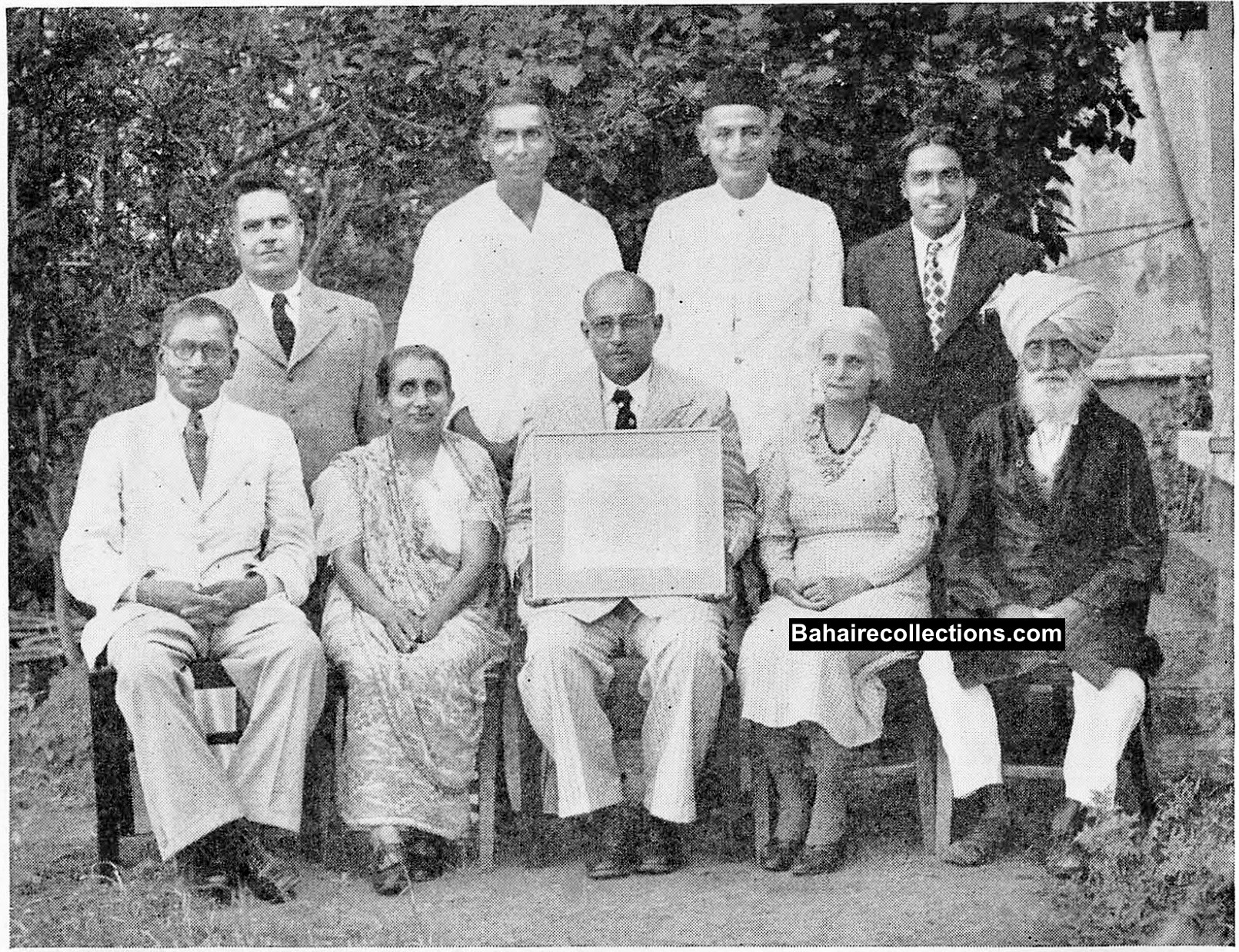
The Local Spiritual Assembly of Bangalore, 1942. Sitting L-R: unknown , Mrs. Sethna, Mr. Gowdy, Ms. O’Doherty, unknown. Standing L-R: my father Soroosh, Hussein, Mr. Swami Wahal, Dr. Ganpaya
The success of my father in establishing the Faith in Bangalore was mentioned in a cable from the Guardian to the believers of India. This cable and the success of my father encouraged many young families to leave their homes and settle in other virgin territories of India.
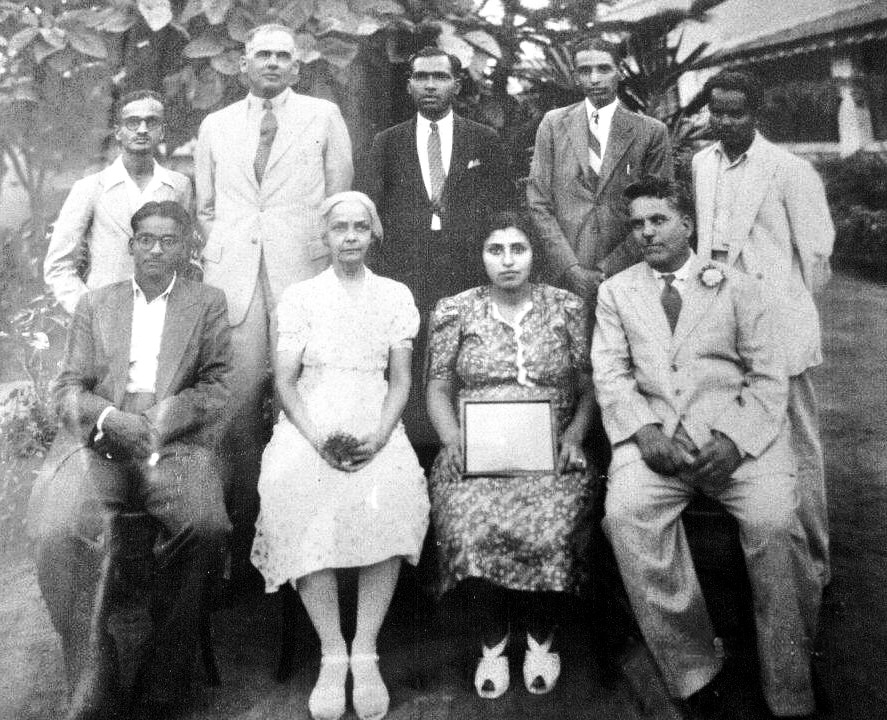
The Local Spiritual Assembly of Bangalore, circa 1953. Sitting L-R: Unknown, Ms. O’Doherty, my mother Firoozeh and my father Soroosh. Standing L-R: Hussain, Gowdi, unknown, Dr. Ganpaya, unknown.
Mr. ‘Abdu’lláh Fáḍil, a young Bahá’í from Persia, was sent by the National Spiritual Assembly of India and Burma to South India to help the communities there. He arrived in Bangalore and helped with teaching the Bahá’í Faith. Fáḍil and my father would go to clubs in Bangalore. Fáḍil was excellent at bringing the Faith to those in the Round Table Group. They held weekly meetings and discussed religious subjects. Fáḍil and my father went to these meetings and explained the subjects under discussion in light of the Divine Teachings. They gave many speeches at the Lion’s Club and Rotary Club. The Bahá’ís became active members of many clubs: The Lion’s Club, The Rotary Club, the Bowring Club, The Round Table Group of Fraser Town, and many other groups.
The Round Table Group studied Bahá’í books at the Palm Road Centre. He put up the Bahá’í Centre signboard on top of the gate. After many years of residing at the Bahá’í Center on Palm Road, my parents bought a farm called Tuba Palace in Sait Palayam, in February 1946, which is in the suburbs of Bangalore. My parents loved the property because their roots were in farming when they lived in Iran, and they loved the farm and immediately bought it. They named it Tuba Palace in honor of our sister Tuba, who was born a couple of years before they acquired this property.
Even after moving out of the Palm Road house, it continued to be used as a Bahá’í Center. Tuba Palace became the epicentre of a lot of activities for the Faith. This is where my other sisters Qudsiah, Nazanin, and my brother Attapur and I were born.
My parents participated in the Intercontinental conference held in New Delhi in 1953 where they met hundreds of believers from various parts of India and abroad. They were thrilled to meet several Hands of the Cause of God who were present, and gathered their signatures on the back of the group photo that was taken at the conference.
Translation and printing Bahá’í books
My father was in constant communication with the Guardian to find out what to do next. One of the tasks the Guardian gave my father was getting the translation of the book “Bahá’u’lláh and the New Era” and prayer books from English into the Kannada, Telugu, and the Tamil languages. Mr. Swami, one of the early believers of Bangalore, would help him get the books printed in Vellore in the neighboring Tamil Nadu state. Mr. Swami owned the Modern Electrical Store on Commercial Street in Bangalore. They both dressed very elegantly, always with suits and hats, because the British had a great influence in Bangalore.
The Guardian had asked my father to send 10 copies of the Tamil translation of the book Bahá’u’lláh and the New Era to the Bahá’ís of Malaya, which was to become Malaysia in 1963. The Guardian had told him to send those copies immediately on arrival from the printers. He made many trips to Madras city (Chennai) in Tamil Nadu until the book was translated by one Mr. “Konaarpattu” Sethuraman and printed in Vellore. He got the books from the printers, and immediately packed 10 copies to be mailed to Malaya. However, when he reached the post office they were closing down for lunch. He told the postal workers how important it was for the books to be mailed immediately. They helped him with his request, and he treated all of them to lunch. My father had sent some copies to the Guardian who placed them in the Mansion of Bahjī in ‘Akká.
The book was popularly in demand in Malaya. The Kuala Lumpur Assembly had written to the Bahá’í Publishing Trust of India in 1960 placing an order for this book. One day Mr. Vasudevan, a Malaysian pioneer to India in 1967, mentioned how the teaching work in Malaysia transformed when they received the 10 copies of the Tamil translation of the book Bahá’u’lláh and the New Era. My father was very happy to hear that.
MASS TEACHING
My parents taught the Bahá’í Faith with great vigor. Around 1959, a Local Spiritual Assembly was established in the twin villages of Sait Palayam and Karianpalya. That was one assembly for both those villages. The first to accept the Faith in Karianpalya was Professor Lakshminarayan, who taught photography at the Polytechnic College in Bangalore. There was great interest in teaching the Faith in the surrounding villages. So, he and our father accompanied each other on teaching trips to our surrounding villages. We siblings used to accompany them on some days.
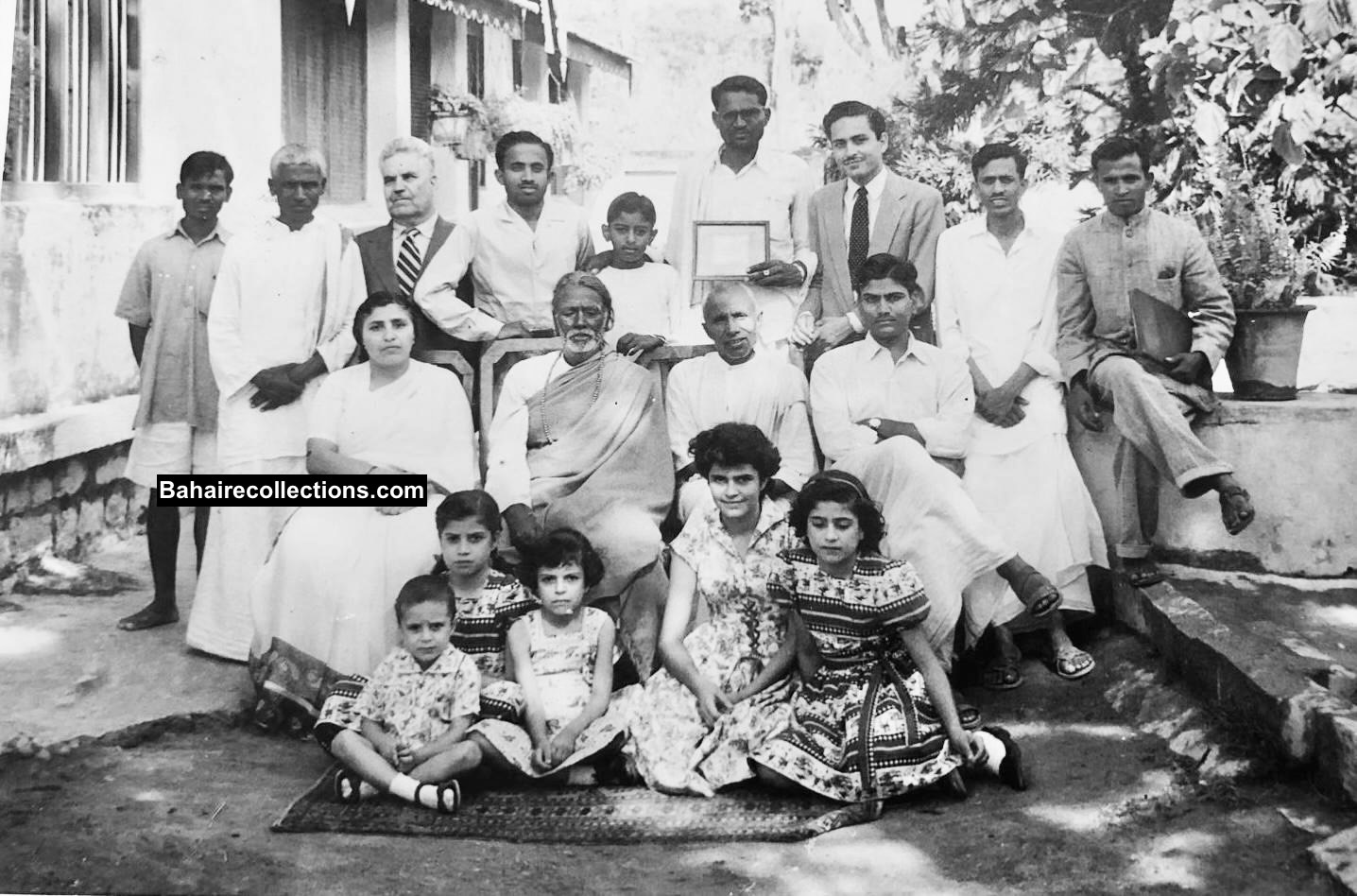
A 1958 photo. Eight members of the Local Spiritual Assembly of Saitpalayam and Karianpalya with other believers at Tuba Palace. The ninth member of the Assembly not in the photo is Lakshminarayan who took the photo. Sitting on the carpet L-R: Attapur, Missaghiah, Nazanin, Tuba, Qudsiah. L-R: Sitting: My mother Firoozeh, Swami, Pillappa Patel, Lakshmipathy. Standing L-R: unknown, Chowdappa, my father Soroosh, Krishna Patel, Krishnappa, Anayat,unknown, unknown.
One day, Lakshminarayan and my father decided to go to the neighboring village of Kacharakanahalli, about a mile away from Tuba Palace in Bangalore. When they reached the bridge near Mr. Munshi’s farm, they sat on the bridge and recited some prayers. Munshi was the owner of the farm next to us. He and his son built aeronautical parts. Their farm and Tuba Palace were separated by a stream. There was a bridge over the stream. There was a bench on it, where we would sit and look at the lake across it. As they were praying, one Mr. Chowdappa came to them and started a conversation. He was from Hennur Village, which was about 3 1⁄2 miles away. They told him about the Bahá’í Faith. He was very interested and invited them to Hennur. They went to Hennur the following Sunday, and this was the start of mass teaching in Bangalore. Since most of the people living in villages were illiterate, they could not sign their names on the Bahá’í Declaration cards. But they affixed their thumbprints, as official signatures, on their declaration cards. The headman in Hennur too accepted the Faith, and in Ridván 1959, the new Local Spiritual Assembly was elected.
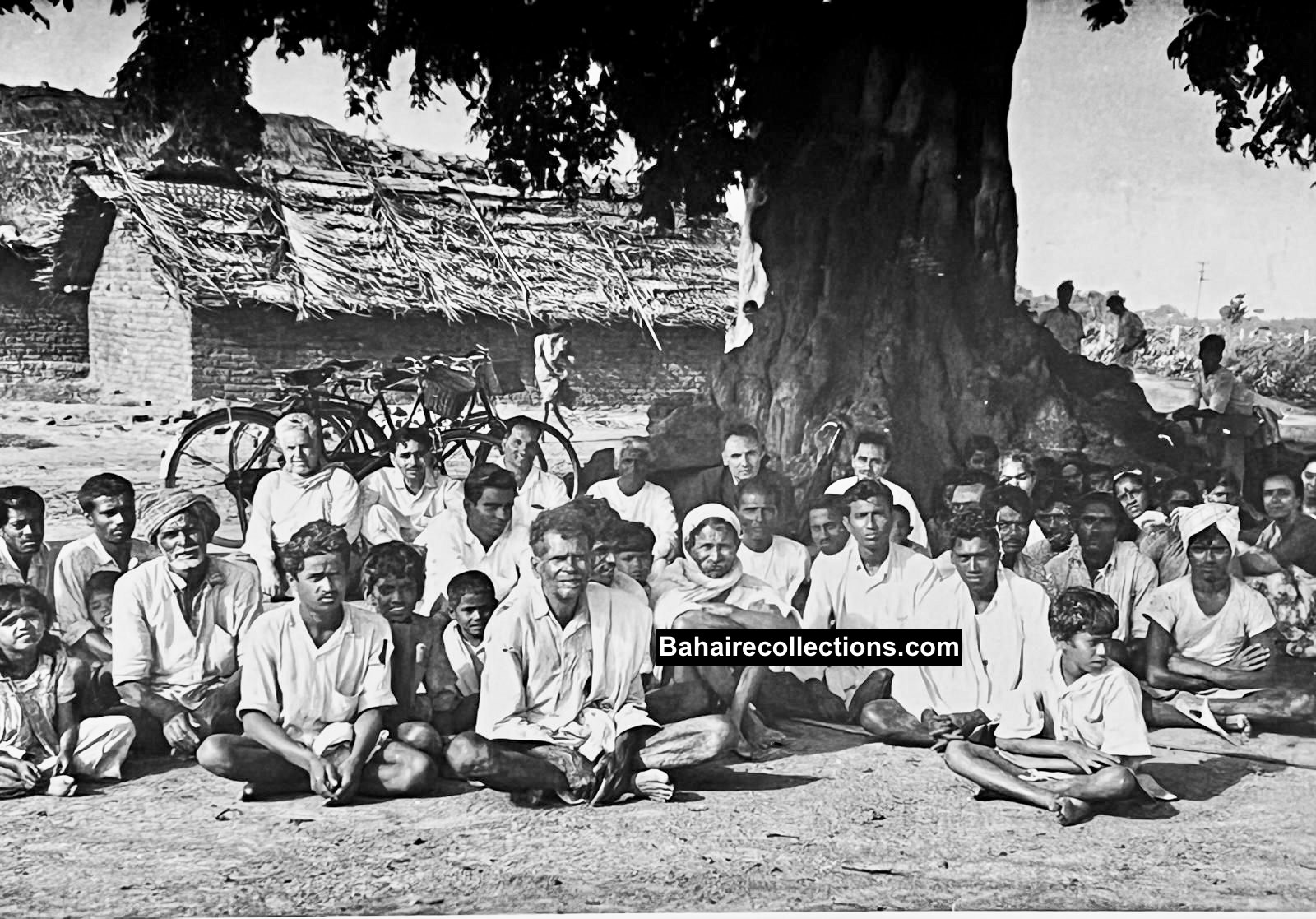
Visit to Hennur Village, early 1969. Hand of the Cause of God Dr. Muhájir is seated in the middle of the back row, attired in black. My father Soroosh is seated at the extreme left in the back row.
As a result of mass teaching, by the early 1960s the Faith was established in the villages surrounding Tuba Palace. They then went to Hoodi which was close to the old airport where Prof. Lakshminarayan’s sister resided. The Faith expanded in this part of Bangalore immensely. My parents, Lakshminarayan, Chowdappa, the family of Mr. Vittal, Gurupad, Vijayarangam, Sambandam and his wife, and many other friends visited the villages regularly, and many Local Spiritual Assemblies were established. Mass Teaching of the Bahá’í Faith gained momentum, and many people in the towns and villages around Bangalore accepted the Faith.
We, the Yaganagi children, Mr. Vittal’s daughters Kalaivani and Vanita, Lakshminarayan’s sons Mohan, Chander, and Srinivas, and other children went on regular teaching trips on the weekends. The family of Vittal spoke the Tamil language as well. They helped by inviting the people to the meetings that were held under trees, or at the village temples. We, the Yaganagi children, invited children from Sait Palayam and Karianpalya to attend the children’s classes which were held at Tuba Palace.
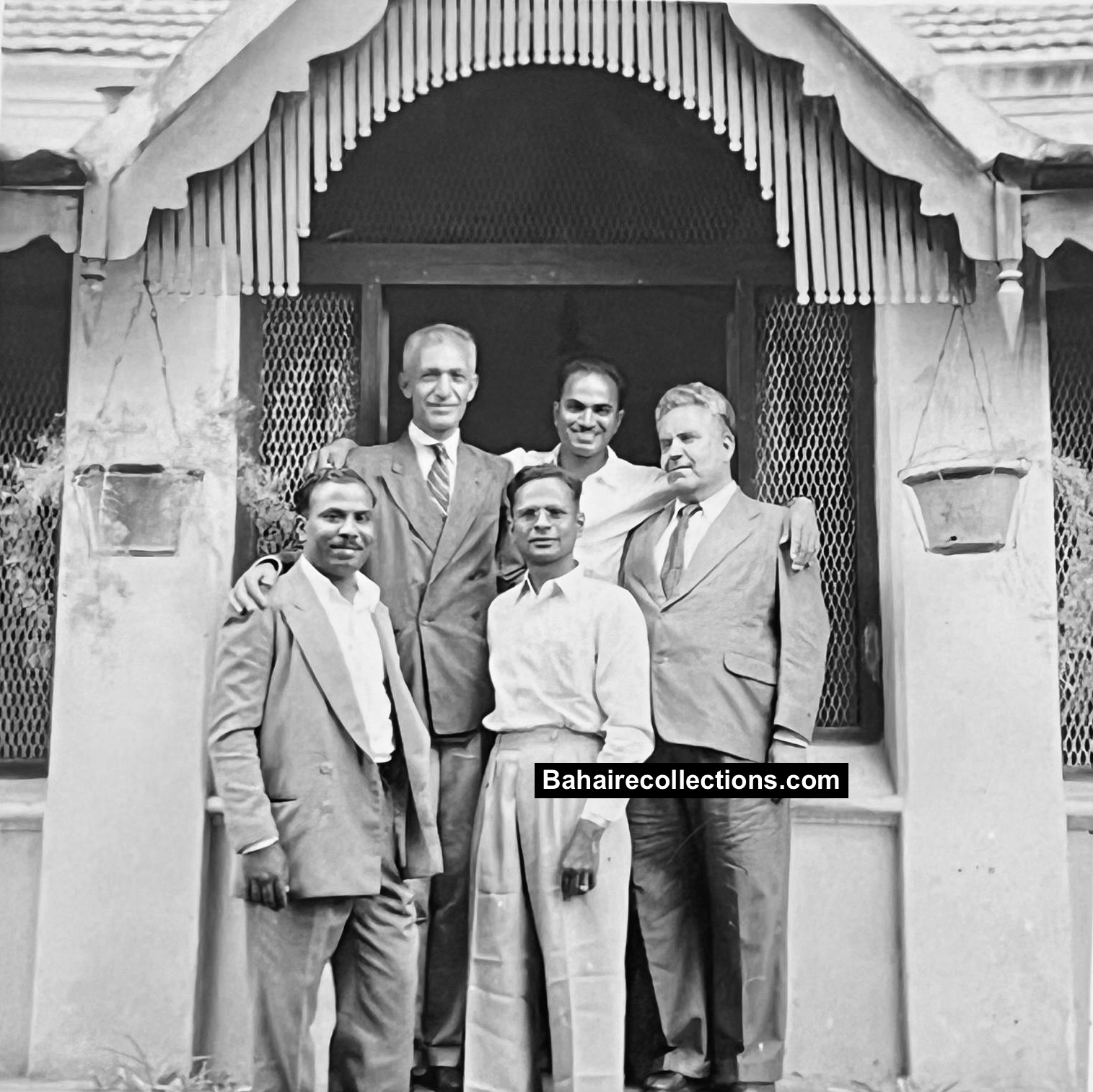
At Tuba Palace, circa 1960. Front row L-R: Mr. Gurupadand Mr. Vijayarangam. Back row L-R: Mr. Mobedzadeh, Mr. S. S. Mani, my father Soroosh

Tuba palace, 1960. Sitting L-R: Tuba Yaganagi, Kalavathy, Qudsiah Yaganagi, Manila, Nazanin Yaganagi, Attapur Yaganagi, Missaghiah Yaganagi. Standing L – R: my father Soroosh, my mother Firoozeh, Anayat Yaganagi, unknown, Raja Vittal, Choudappa, Bahram Ayadi, Ms. Buckle, Simin Ayadi, Swami Muniswami.
It was during this time that the Local Spiritual Assembly of Bangalore was gifted with a jeep to assist with teaching the Faith. Mr. Bahram Ayadi drove the jeep to Bangalore and was the driver for a few months together with his nephew Jehangir Rastenehad, until Mr. Ratnam was hired. My mother learned to drive the jeep so she could travel long distances to go to neighboring villages to teach the Bahá’í Faith. We would sometimes go with her. The teaching zeal in us was the product of my parents involving us in field teaching from the beginning.
Most of these teaching trips that my parents took happened in the evenings. My father would pick up Lakshminarayan from the Polytechnic College in the jeep, and they would go teaching. They usually returned around midnight. Ratnam never complained that it was late. He declared his faith in Bahá’u’lláh. On some nights my mother would relieve Ratnam. Ratnam was a great mechanic, so we paid very little for fixing the jeep whenever it broke down. Most of the villages did not have electricity, so they took a lantern with them. They also took pamphlets translated from English into Kannada, Tamil, and Telugu, languages spoken in the vicinity of Bangalore. They had ink pads and Bahá’í declaration cards. Since most of the people in the villages were illiterate, their thumbprints were affixed as a legal way of signing the Bahá’í Declaration cards.
AMATU’L-BAHÁ VISITS BANGALORE
In 1964, Amatu’l-Bahá Rúhíyyih Khánum and Mrs. Violette Nakhjavani visited Bangalore. Rúhíyyih Khánum wanted to open a new village for the Bahá’í Faith. It was decided by the Area Teaching Committee to take her to Kadagrahara village. It was in this village that Rúhíyyih Khánum mentioned that she had never signed the Bahá’í Declaration card and would like to do so. During the days of mass teaching, those friends who became Bahá’ís signed their names on a form and affixed their thumbprints. Rúhíyyih Khánum too signed her name and also affixed her thumbprint on a Bahá’í Declaration card. Violette Nakhjavani has mentioned this in her book “Amatu’l-Bahá Visits India”. This document was immediately sent to the National Spiritual Assembly of India. When they were on their way to the village in the late evening, it was very dark and the jeep they were riding in got stuck in the mud. All of them got out and pushed the jeep out and reached the village. Since the villagers were informed about Rúhíyyih Khánum and Violette Nakhjavani’s visit, they had already assembled at the local temple. Rúhíyyih Khánum laid the cornerstone for the Bahá’í Center for Kadagrahara that night. A Bahá’í Center was later built on that site. On their return from the village, all the friends were served dinner at Tuba Palace. A group picture was taken with Rúhíyyih Khánum and Violette Nakhjavani. While she was in Bangalore, she was happy to see mass teaching taking place with great success. She also laid the cornerstone for the Bahá’í Center of Saitpalayam and Karianpalya. The plot of land was donated by the headman of the village, Pillappa Patel. A beautiful Bahá’í Center was built on that plot and was used for various activities in Karianapalya.
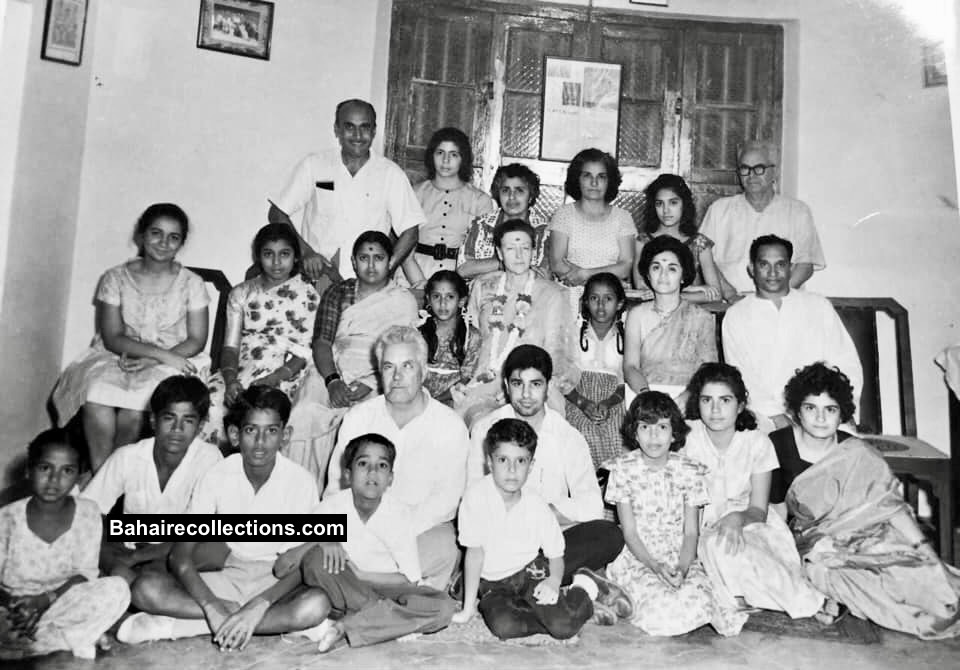
Amatu’l-Bahá meets the community at Tuba Palace. Back row L to R: Mr. Lakshminaryan, 3rd my mother Firoozeh, 4th Rezwan Mobedzadeh, 6th Isfandiar Yaganagi. On the chairs: L to R: 3rd Mrs. Lakshminaryan, Chitra Lakshminaryan, Amatu’l-Bahá, Vijayalakshshmi Lakshminarayan, Violette Nakhjavani, Raja Vittal. On the floor L to R: 3rd Srinivas Lakshminarayan, 4th my father Soroosh, Jehangir Rastinehad, Attapur Yaganagi, Nazanin Yaganagi, Missaghiah Yaganagi, Qudsiah Yaganagi.
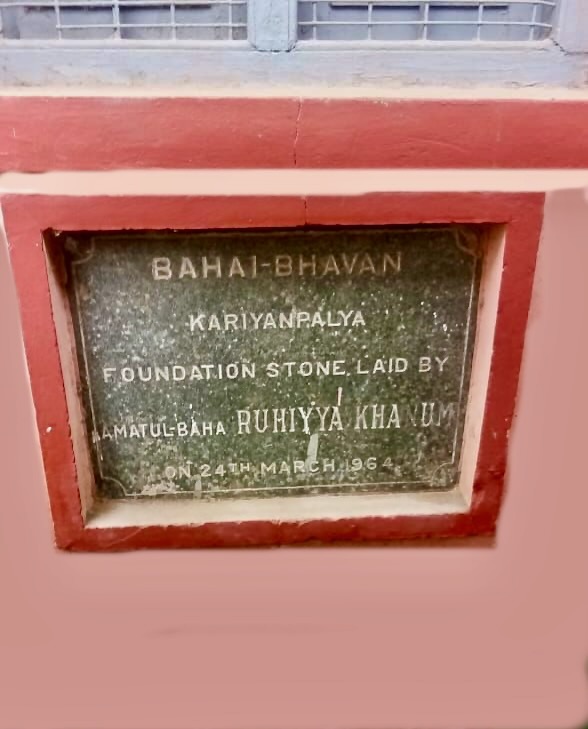
Foundation stone that Amatu’l-Bahá Rúhíyyih Khánum laid for the Bahá’í Center of Karianpalya
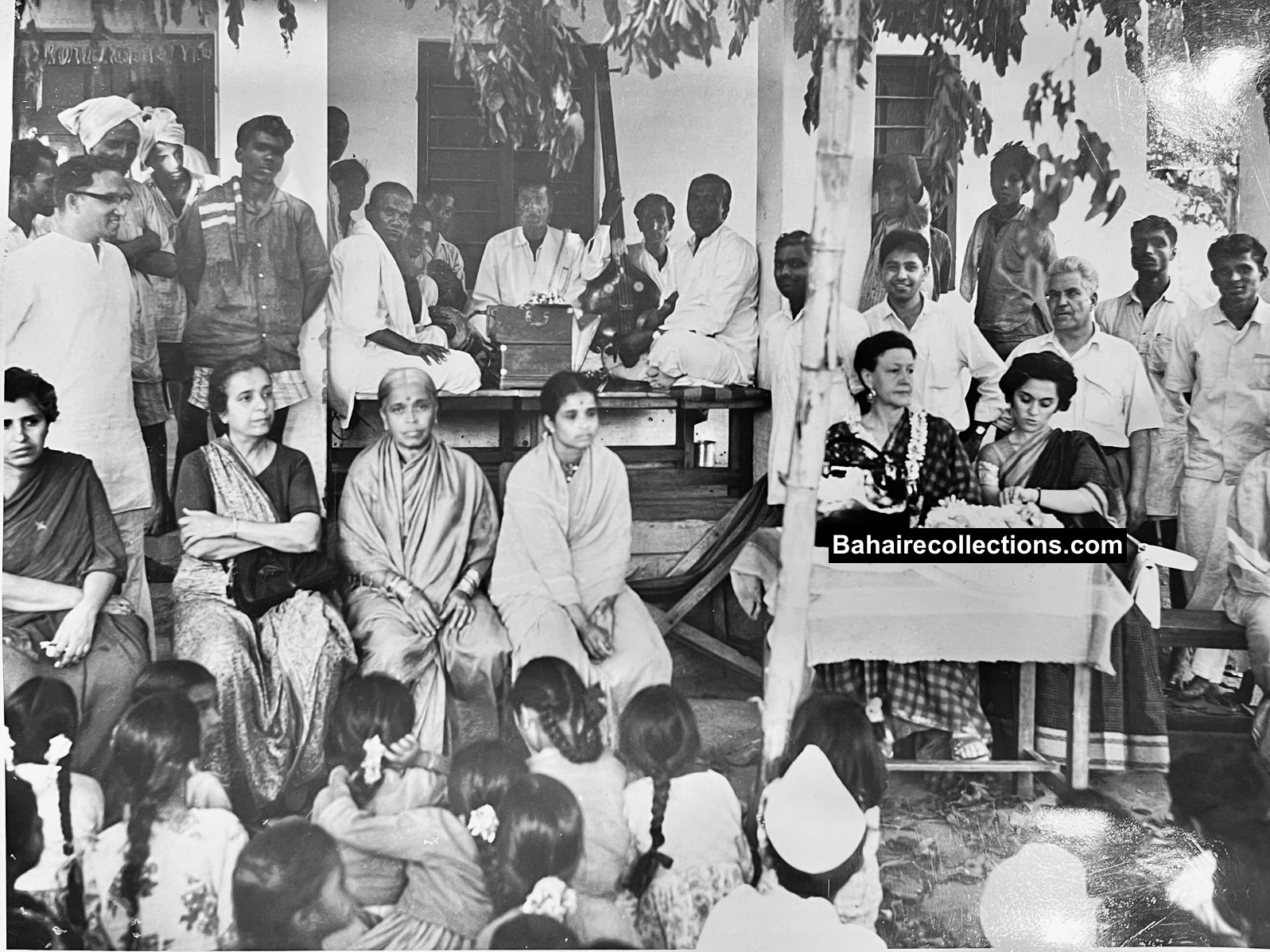
A 1964 photo with Amatu’l-Bahá Rúhíyyih Khánum in Karianapalya, after laying the foundation stone for the Bahá’í Center of Karianpalya. Sitting L to R : My mother Firoozeh and Mrs. Shirin Boman. Standing behind my mother is Raja Vittal. At the table L-R: Amatu’l-Bahá Rúhíyyih Khánum and Mrs. Violette Nakhjavani. Behind Mrs. Nakhjavani is my father Soroosh.
VISITS BY OTHER HANDS OF THE CAUSE
During these years of intense mass teaching of the Faith, many Hands of the Cause visited Bangalore, and the Yaganagi Family had the bounty of hosting them. Dr. Raḥmatu’lláh Muhájir visited on numerous occasions and was a beacon of light to all. Other Hands of the Cause that visited were Mr. Horace Holley, Mr. Tarázu’lláh Samandarí, Mr. Jalál Kházeh, Mr. Enoch Olinga and his wife Elizabeth, Mr. Paul Haney, Mr. ʻAlí-Akbar Furútan, Mr. Adelbert Mühlschlegel and his wife Ursula Kohler, Mr. Collis Featherstone and his wife Madge Featherstone. Mr. Jalál Kházeh had stayed for one month during his visit. Hand of the Cause Mr. Tarázu’lláh Samandarí was also a calligrapher, and he made many pictures of the Greatest Name when he stayed for one and half months. He also presented the Yaganagi family with one which they had framed and placed in the Hall Room. Many of the Hands of the Cause who resided at Tuba Palace joined the family in daily devotions.
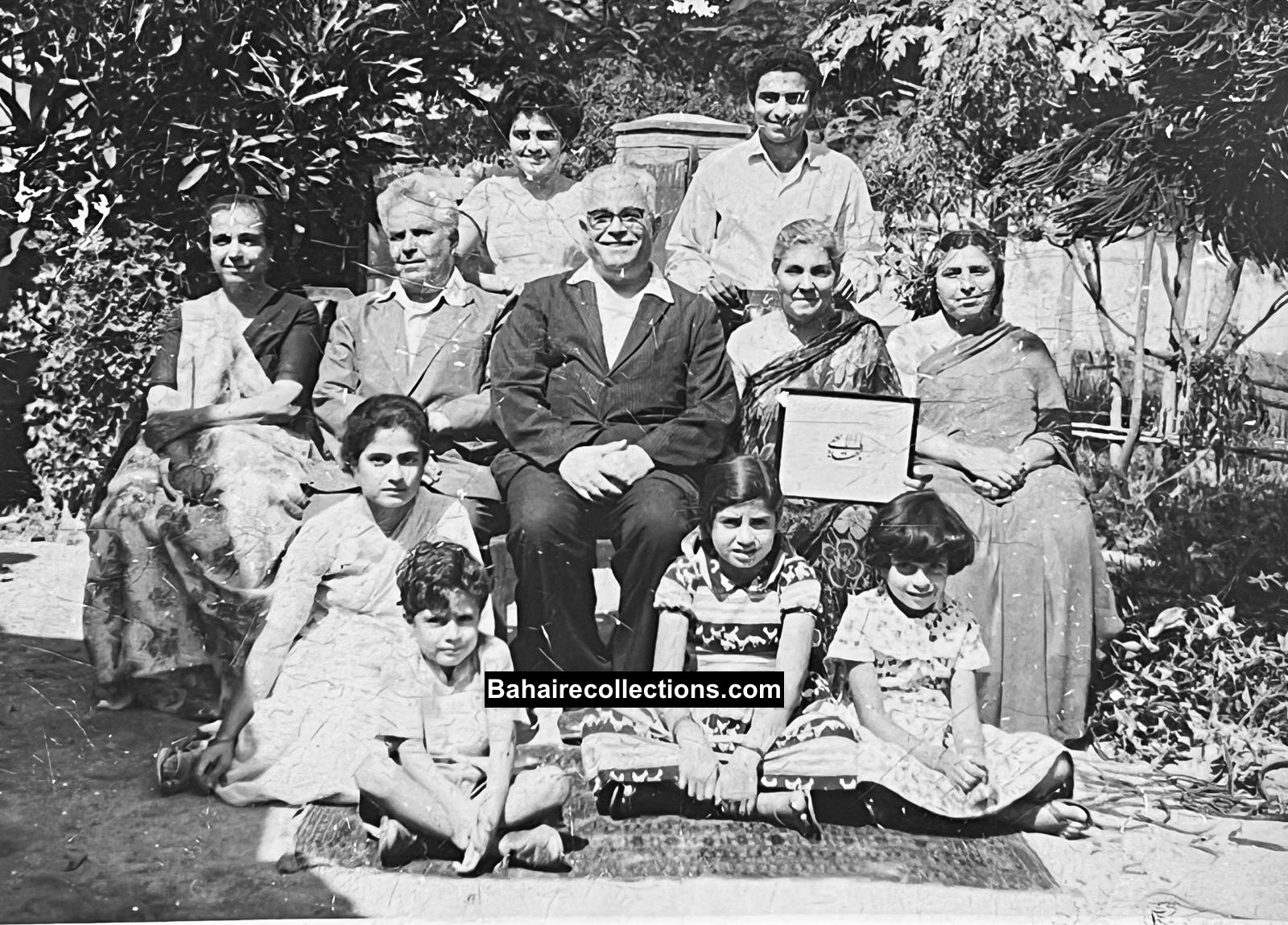
A 1960 photo. On the floor L-R Qudsiah, Attapur, Missaghiah and Nazanin. Sitting on the chair L-R: Mrs. Shirin Boman, my father Soroosh, Hand of the Cause of God Mr. Jalál Kházeh, Keshwar Yaganagi (my uncle Isfandiar’s wife), and my mother Firoozeh. Back row L-R: Tuba and Farrage
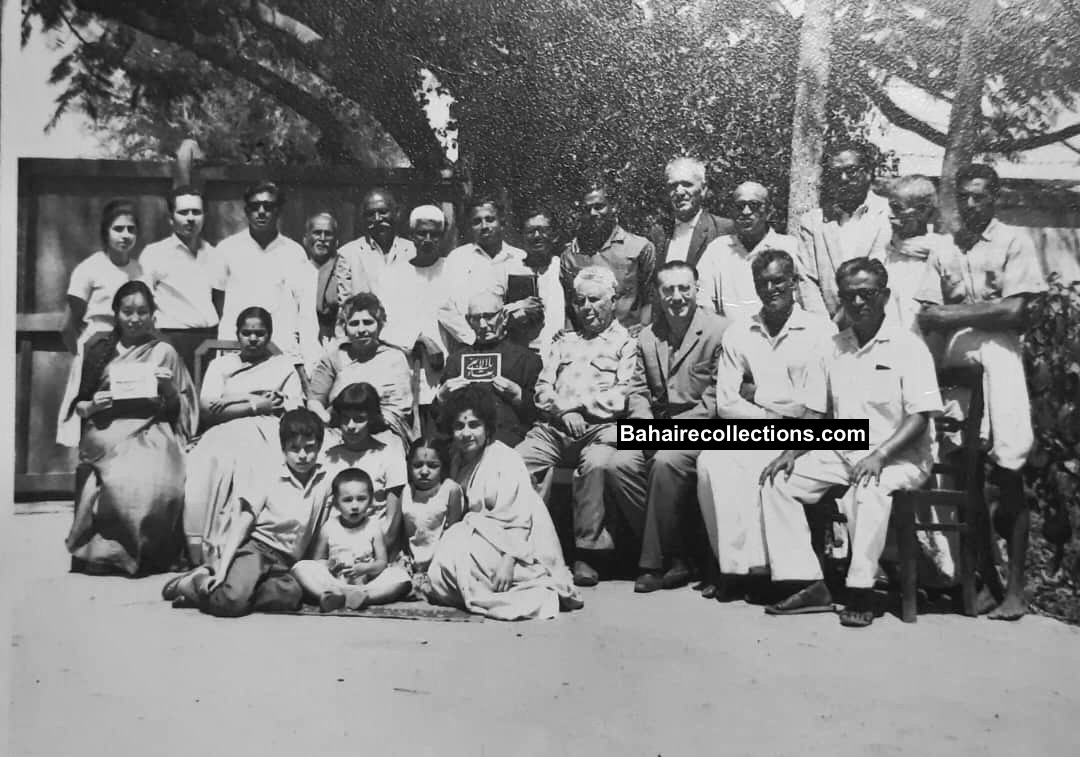
A 1967 visit by the Hand of the Cause of God Mr. Tarázu’lláh Samandarí to the Tuba Palace. On the floor L – R: Attapur, Nazanin, Monira,unknown, Qudsiah. Sitting L-R: Lingshay, Mrs. Sambandam, my mother Firoozeh, Mr. Tarázu’lláh Samandarí, my father Soroosh, Dr. Mehdi Samandari, unknown, unknown.Standing L to R Missaghiah , Anayat, L.Mohan, unknown, Ratnam, Choudappa, Krishna Patel, unknown, unknown, Shahbehram, Advocate Naidu, Sambandham, Muniswamy, Abbaya.
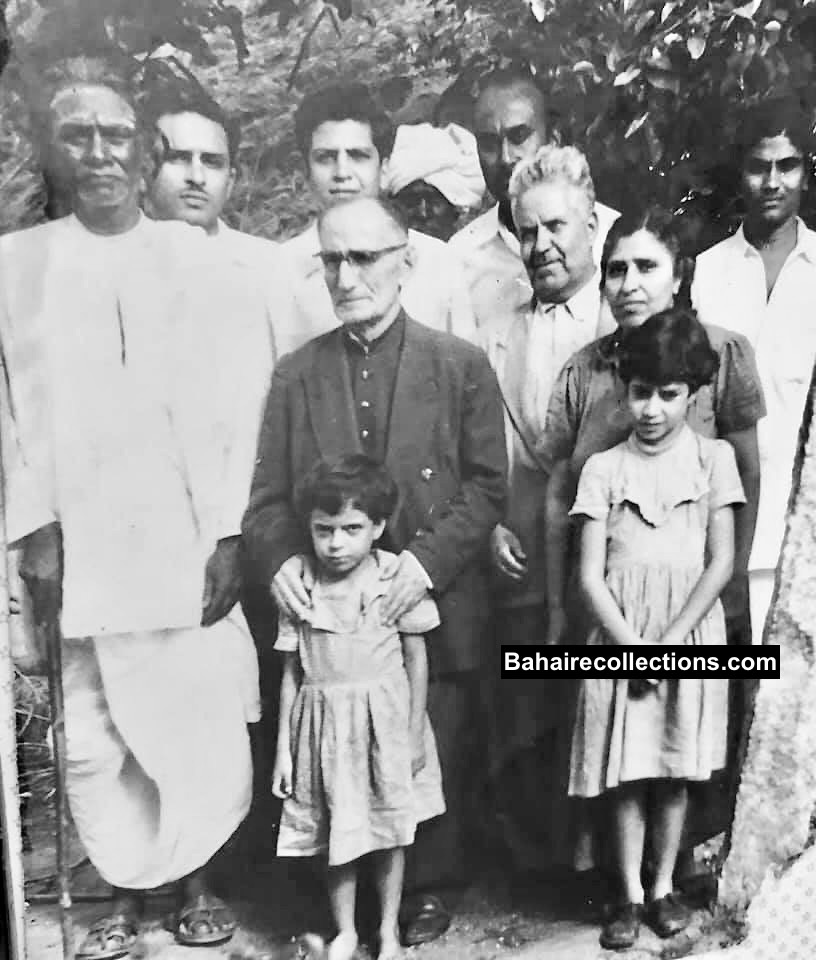
The 1967 visit by Mr. Tarázu’lláh Samandarí. Front row L-R: Nazanin and Missaghiah. Back Row L-R: Swamiji, Hand of the Cause Mr. Tarázu’lláh Samandarí, my father Soroosh and my mother Firoozeh. Back row: Anayat Yaganagi, Faiz Yaganagi, unknown, Lakshminarayan, Lakshmipathy.
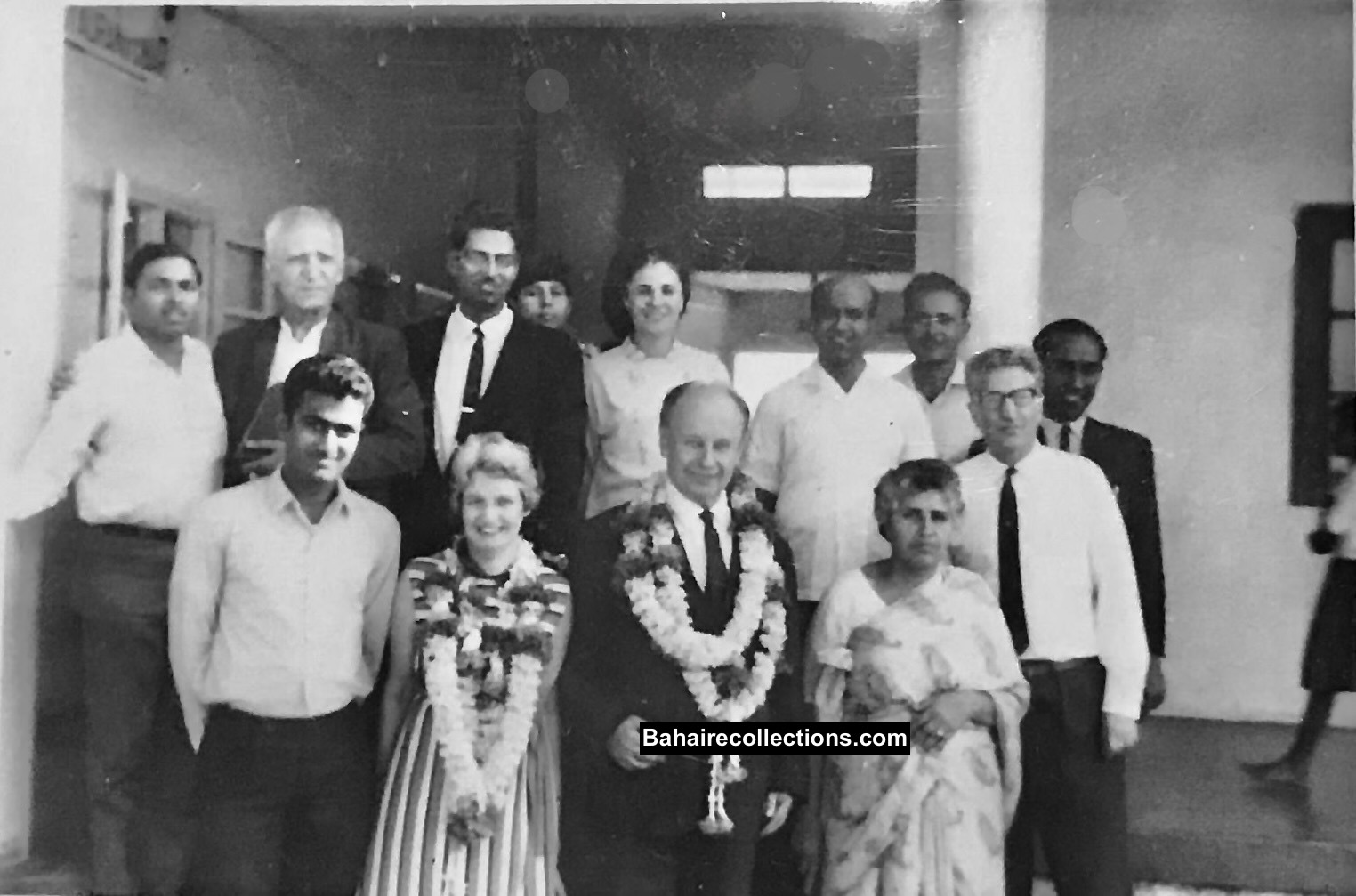
A 1969 visit by Hand of the Cause of God Mr. Adelbert Mühlschlegel. Front row L-R : Chander Lakshminarayanan, Mrs. Ursula Kohler, Mr. Adelbert Mühlschlegel and my mother Firoozeh. Back row: L to R: Sabapathy, Shahbahram Mobedzadeh, Vasudevan, Foad, Simin Moghaddas, Mr. Naidu, Anayat, Mehraban, unknown.
There were also other visitors, like Mr. Hushmand Fatheazam who visited in 1969. Mrs. Gloria Faizi stayed for a month at Tuba Palace, where she concentrated on writing her books. Members of the National Spiritual Assembly of the Bahá’ís of India, Pakistan and Burma such as Mr. Lukmani, Mr. Bakhtiari, and Mr. Abbas Ali Butt too had visited. Many members of the National Spiritual Assembly stayed at Tuba Palace when they came to meet with State Teaching Committee, and the Local Spiritual Assembly to discuss the advance of the Faith, and also to attend many national, state, and regional conferences. It was a hub of constant activities. Bahá’í Scholars from Iran such as Mr. Eshragh Khaveri and Mr. Bakhtavar conducted deepening classes for all Iranians who assembled in Bangalore.
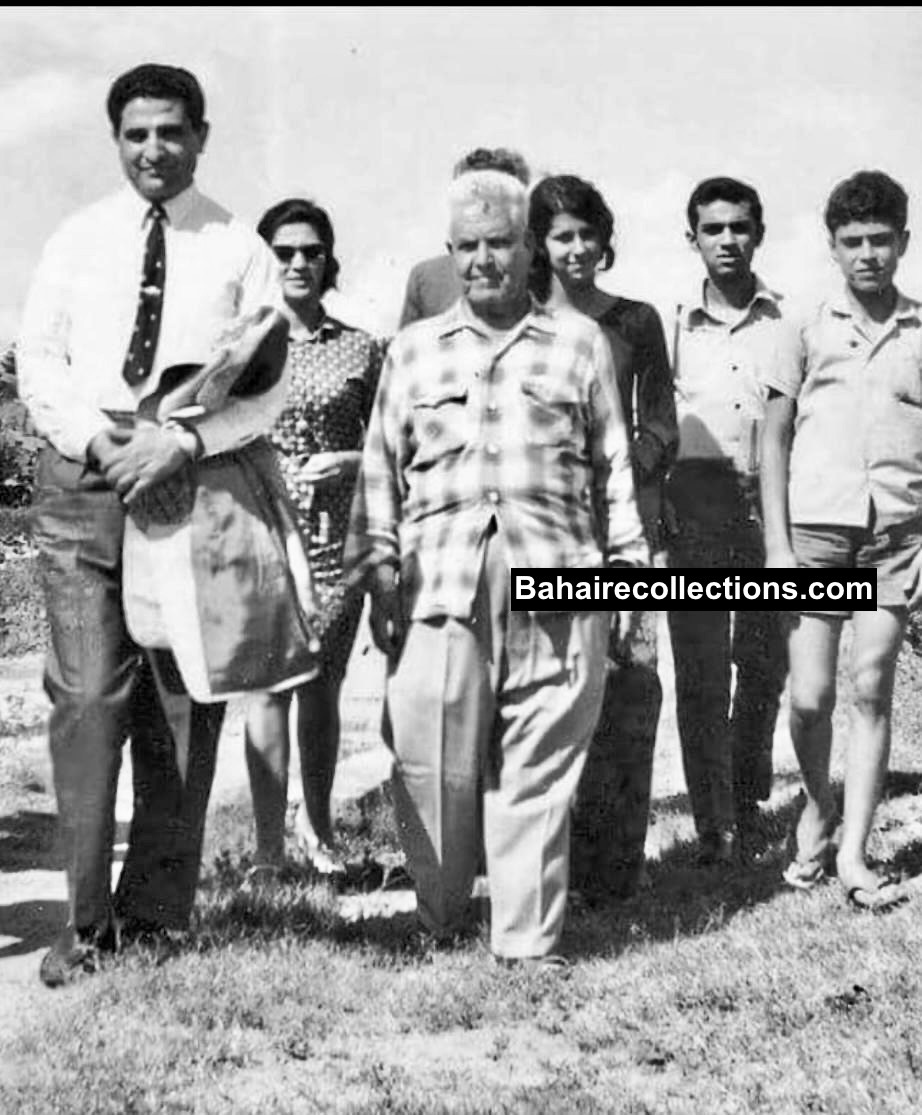
The 1969 visit by Mr. Hushmand Fatheazam. To the right of Mr. Fatheazam is my father and to the extreme right is Attapur.
Bangalore become a very active community for mass teaching. Many traveling teachers passed through, and always stayed at Tuba Palace. Mr. Shahbahram Mobedzadeh visited us regularly. He was from Pune but was sent by the National Spiritual Assembly to visit the Bahá’ís in the Southern States. He was a great teacher of the Faith. He woke up very early in the morning and chanted prayers aloud in Farsi. Mr. S. Vasudevan from Malaysia lived at Tuba Palace for many months when he first arrived from Malaysia in 1967. Tuba Palace was his hub. Mr. Sababathy Alagiah who later married my sister Qudsiah in 1968, who also arrived as a Malaysian pioneer to India on the same day as Vasudevan, had made Tuba Palace his hub. Dr. Muhájir brought these two vibrant teachers to Tuba Palace.
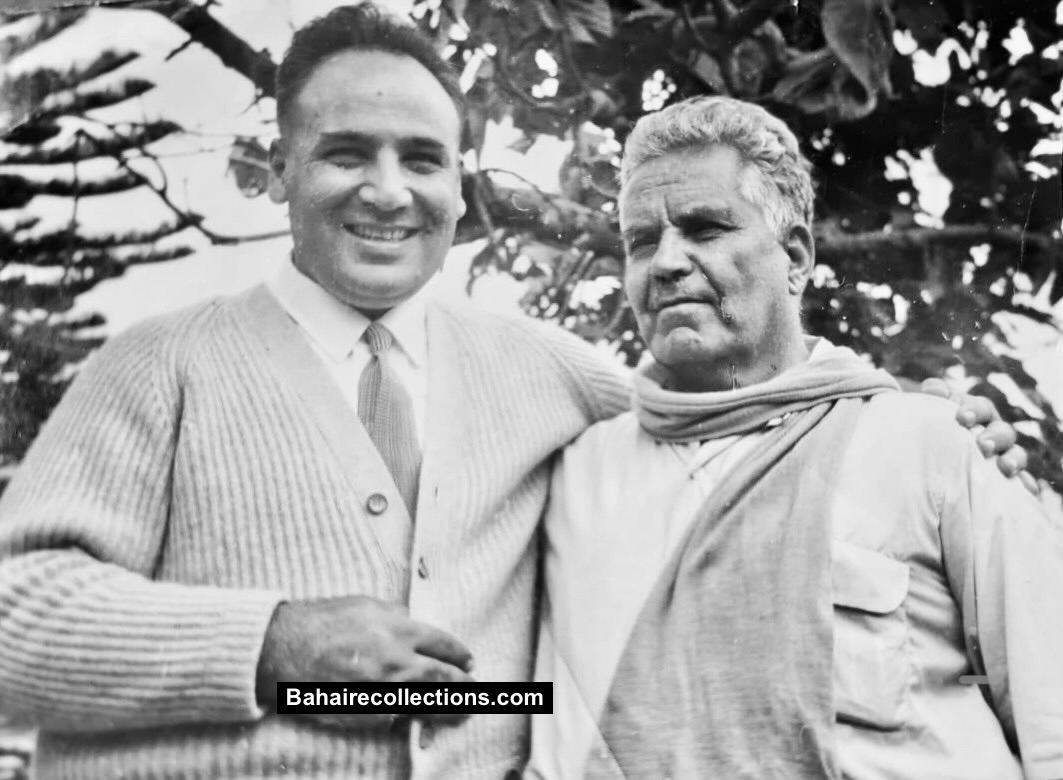
A 1963 photo. The mutual love between Dr. Muhájir and my father was boundless.
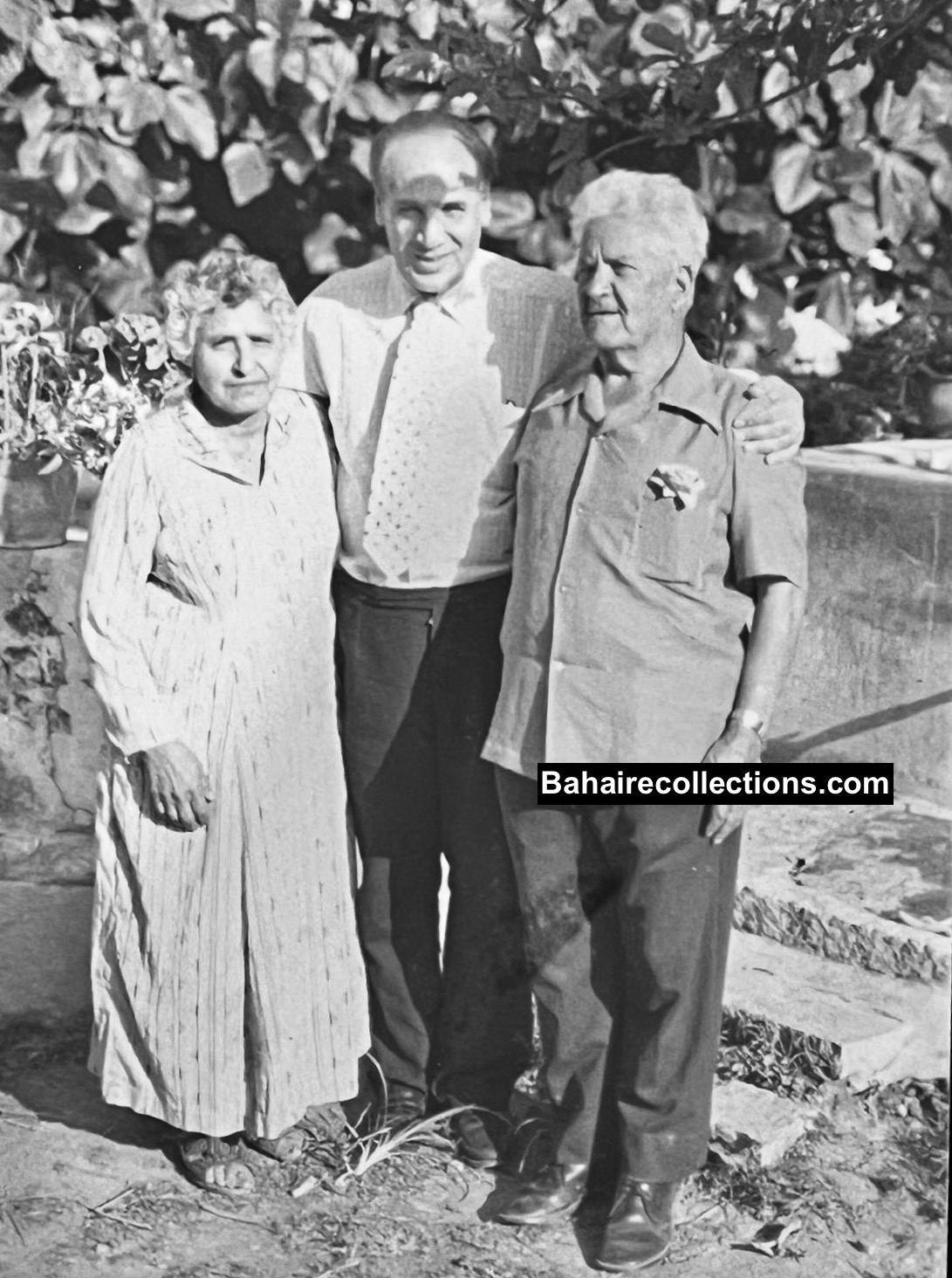
Dr. Muhájir at Tuba Palace in 1979. Dr. Muhájir flanked by my mother Firoozeh at left and my father Soroosh at right.
FATHER LED THE WAY
My parents were both very spiritual people, though they had no formal education. But what they have accomplished for the Faith and for the family is phenomenal. It has to be mentioned that my parents inculcated Bahá’í principles and values in us children from our childhood days. The eight siblings are four boys and four girls. The boys are Anayat, Farrage, Faiz, and Attapur, and my sisters are Tuba, Qudsiah, Nazanin and my own self, Missaghiah. We are forever indebted to our parents for giving us the Faith and nurturing us in the Bahá’í way.
My father chanted many prayers every morning. This helped the children memorize many of the prayers and poems. Also, before the children left for school, they had to say their prayers. My parents and we eight siblings had devotions every night after dinner. After prayers by each one of us, a selected book was read.
My father had a fund box made of Rosewood placed in the living room at Tuba Palace. All the children and Bahá’í friends were encouraged to contribute to the fund. The members of the Local Spiritual Assembly enjoyed counting the coins regularly, and surprisingly, a big sum was collected, and the donation was sent to the National Spiritual Assembly.
My father was a voracious reader of Bahá’í books. In the early years, a few Bahá’í books were printed in Farsi in Karachi and brought to Bombay. And later were printed in Bombay. As soon as my uncle Isfandiar found out that a new book was available, he got the night train to Bombay to buy the books and returned to Pune the next morning. He read the books and mailed them to my father in Bangalore. My father would transcribe the books with his own hand and return them to my uncle Isfandiar. After that, my uncle Isfandiar displayed these books in a showcase at the National Hotel in Pune. There are many volumes of these handwritten books by my father.
My father read Bahá’í books as though he was going to write a thesis. He used to go line by line, underline some parts and wrote notes in the margins. It was through this example by my father that we siblings developed this craving to read for knowledge. Thus, even at an early stage, we became avid readers.
MOTHER’S SERVICES
After my mother got married, she and a few other Iranian mothers started moral classes for their children in Pune. This group of ladies later started a school and named it “Ideal Baha’i School”. My mother helped teach handicrafts, sewing, and knitting to the children at the Ideal Bahá’í School in Pune. A few years later the school was transferred to Panchgani to become the New Era High School.
My mother was brilliant at learning new languages. This strength of hers helped with teaching the Faith to a wider circle of people. She spoke Farsi, Gujarati, Marathi, English, Kannada, Tamil, and Urdu very fluently. She had heard that Esperanto had the potential of becoming a universal language. So she studied Esperanto too. Before her passing in Laos, she was learning the Lao language, so that she could start teaching in areas around Vientiane, Laos.
When in Bangalore, my mother always wanted a school in the village of Karianapalya. She was always encouraging parents to send their children to school. The children had to help with grazing the cattle, especially the girls. The closest government school was about 3 1⁄2 miles away in Shivaji Nagar, which was impossible to attend due to not having any transportation. The private schools were very expensive. My mother was the first woman appointed to the Village Panchayat (Council) of Saitpalayam and Karianapalya and was also the Chairperson. The first thing she did was to rally on getting a teacher and starting the school. My mother would visit all the homes and encourage parents to send their children to school. She was also successful in getting the girls to come and join the schools. She urged the Bahá’í travelers who passed through Bangalore to support the school with funds for stationery and books. A hall was built near the Kariyanapalya Bahá’í Center, a teacher was hired, and the school was established. The school was from grades one to four. The Bahá’í Center was also used for additional space to teach and to feed the school children. Bus route number 55 started and after their fourth grade, the girls went to Nirmala High School, and the boys went to the government school in Shivaji Nagar.
My mother was at the forefront of social justice too. She took an active role in the rights of women and workers, and the rights of the “harijans” or low caste people. These were foremost in her agenda, and she involved us all in her activities.
She would go to the homes of the Dalits (harijan) and eat in their homes and would invite them to eat at our home. She took care of all the harijan people in our village, and even fought with local authorities to get them their own land on the outskirts of our village. Although it was considered a taboo, my mother hired them to work in our house and farm. There were talks in the village when she initially did that and initially some people refused to eat anything in our house, but she went ahead. She knew that was what the Bahá’í Faith was all about.
My mother distributed extra fruit and vegetables that we grew on the farm to people who needed them. We had a bakery on the premises of Tuba Palace. The poor people got their bread at a minimal price as many could not afford it. Each year the Parsees of Bangalore would come to our farm after their Persian Naw-Rúz and have a big celebration of meeting each other. My parents provided them with ample food.
As a lover of humanity, my mother treated everyone with boundless love. The farm in Tuba Palace had a lot of fruit trees and vegetables for our daily use. The neighboring children would come over, and we would play a lot of games.
The Bahá’í holy days of Naw-Rúz and Ridván were celebrated throughout the whole community. On Naw-Rúz day sheep were slaughtered, and cooks were hired to make biryani (rice/meat dish) with all its sides and was served to people in the surrounding villages. Many Bahá’ís and friends from our neighboring villages attended. Some poor people were given portions of the meat to take home. The main gate was left open for whoever wished to come and eat.
JOY OF NINETEEN DAY FEASTS
Until the early 1950’s the family attended the Nineteen-Day Feast at the Palm Road Bahá’í Center in Frazer town, which was their family home. Ms. Doherty, who tutored Anayat, Farrage and Faiz, also taught English to my parents and we siblings. Ms. Doherty was the caretaker at the Center and was a great hostess. After a few years, in the late 1950s, the Bahá’í Center was relocated to Mr. and Mrs. Vittal’s residence. They were among the oldest believers of Bangalore.
And when the Bahá’í Center moved to Vittal’s house, the Yaganagi family had to catch two buses and walk one and a half miles to attend the Nineteen Day Feasts. The older boys used their bicycles to help the younger ones get to the bus stop at Davis Road or Palm Road. It was not easy for the family to get on the bus. My mother had to do a head count after all the children got on the bus.
Yet, it was a joy to see many friends at the Feast. Mrs. Fitzgerald, an elderly lady and one of the early believers of Bangalore brought her heavy accordion and sang many uplifting songs together with all of those that attended. She used to sing and dance as well. My father would also get up and dance with her. Some of the younger children dozed off during the feast. Dr. Saroja Bai made the most delicious tea and served it in beautiful special glass tea cups. Dr. Saroja Bai and my eldest brother Anayat were classmates at the Bangalore Medical School. She spoke good Tamil.
When the Local Spiritual Assembly was established in Sait Palayam and Kariyanapalya the Feasts were observed at Tuba Palace. My father prepared the physical arrangements for the Feasts, while my mother prepared the refreshments. The attendance was great-around 25 to 30 attended. Sunday Devotions were held at Tuba Palace at 8:00 am, but after the Bahá’í Center was built it was moved there so we could accommodate the large numbers that attended. When we had meetings in the evenings there was a person called the Village Crier (Thoti), who helped call the village people to the meetings.
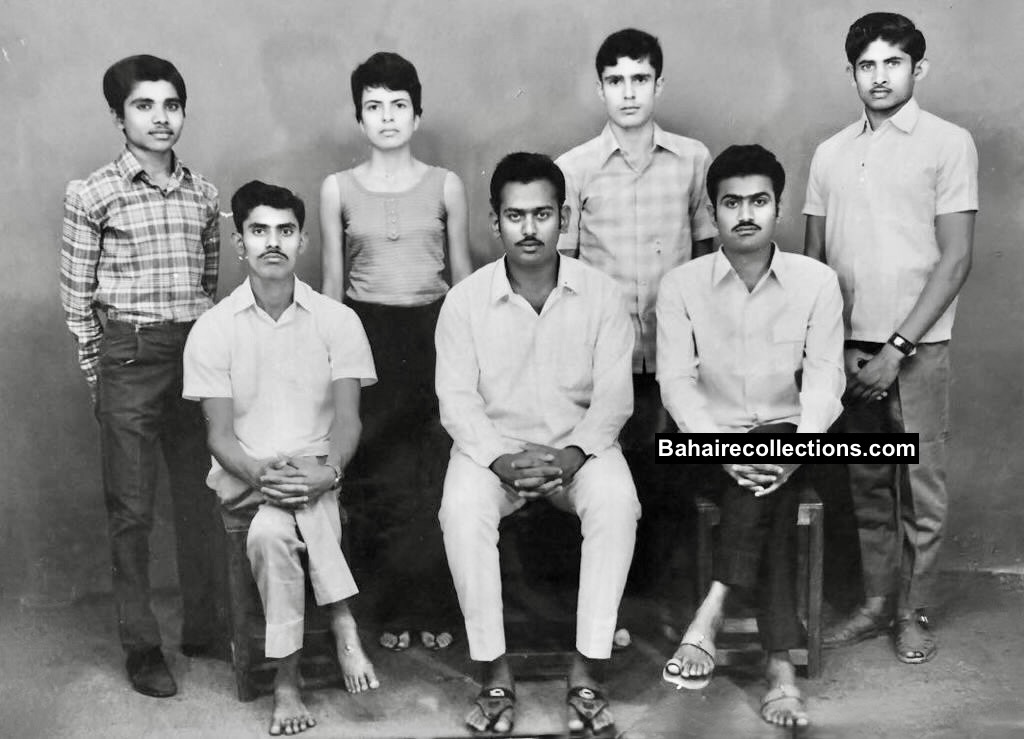
1968 Youth committee of Saitpalayam and Karianapalya. Standing L to R: Gowreesh, Nazanin, Attapur, Rambahadur. Sitting L to R: Kodanramaiah, Srinivas, Chander Lakshminarayan.
PIONEER FAMILY
All the days of their lives my parents worked hard to get their children educated spiritually and academically. All their eight children were able to pioneer to various places in this wide world.
Anayat Yaganagi
My eldest brother Anayat was born on April 5, 1936, in Pune. He became a medical doctor. He worked at the Victoria Hospital in Bangalore, then pioneered in Ceylon (Sri Lanka) for a couple of years. On his return from Ceylon, he started the Yaganagi Clinic at Tuba Palace, and many patients from the surrounding villages came to this clinic. Anayat traveled to Bombay and over there he met a high official from the Government of Bhutan who encouraged him to go to work in Bhutan, and to be the doctor for workers building the road from the border of India to Phuntsholing in Bhutan. He accepted the offer and pioneered to Bhutan.
He married Lingshay Foning, who was from the Lepcha tribe of Kalimpong near Darjeeling, and they have 6 children: Monira, Vedah, Medon, Geeti, Isfandiar, and Kesang. Anayat was Chief Medical Officer and Director of Health for the government of Bhutan. He was bestowed Bhutanese citizenship due to his dedication to the people of Bhutan. He was instrumental in eradicating Leprosy from Bhutan. Anayat and Lingshay pioneered to Gelephu in Bhutan.
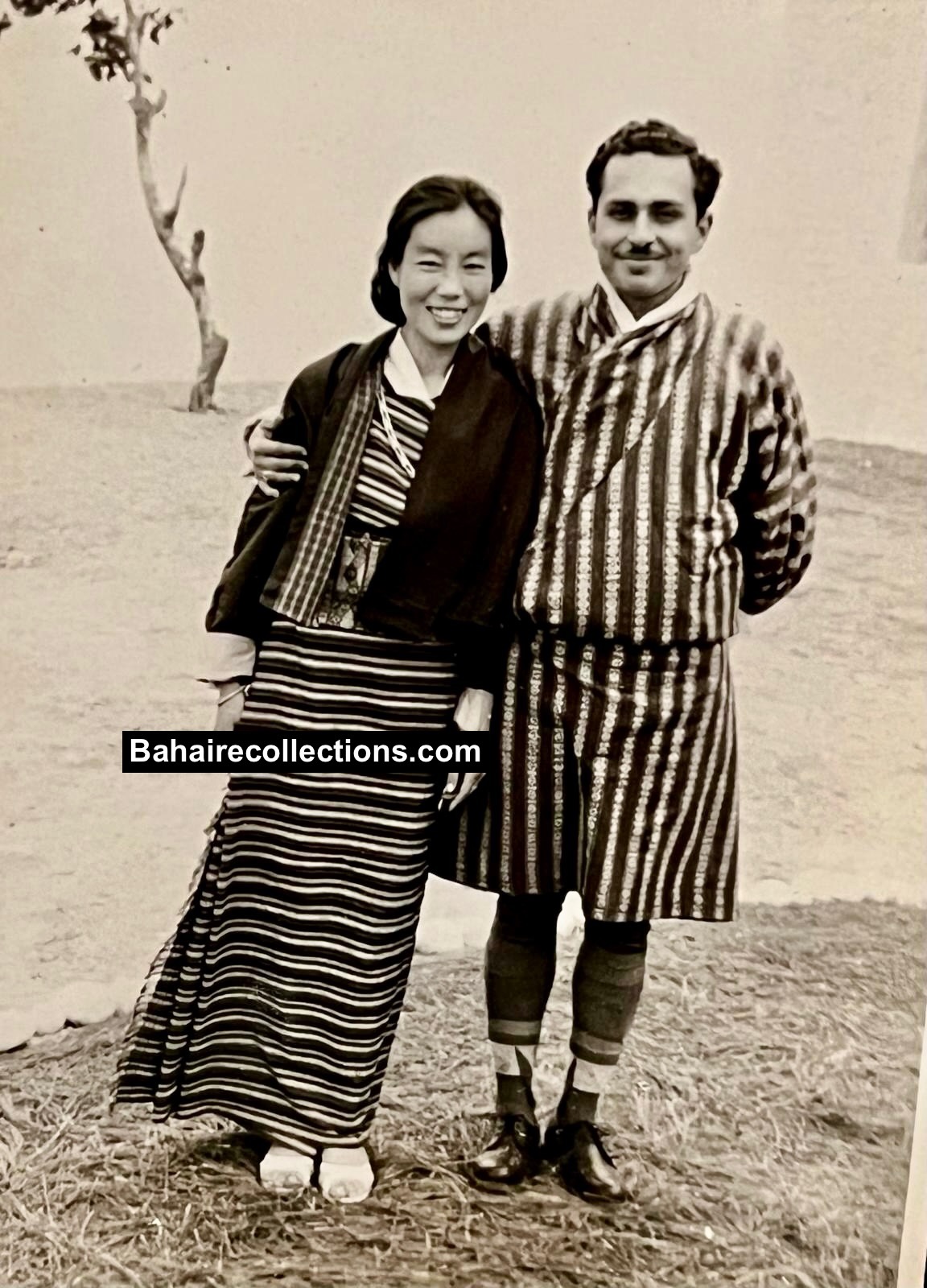
Lingshay and Anayat
Farrage Yaganagi
My brother Farrage was born July 6, 1938, in Pune. He had degrees in Commerce and Law. He managed the Mubarak Hotel for many years. The income supported the children’s education, and the Bahá’í teaching efforts. He later pioneered in Goa and Daman in South West India for many years, and then went to manage the Lucky Restaurant in Pune for many years.
He married Hamra Fazil in 1968. It was her father who helped with teaching the Faith in Bangalore. They have five children – Izzat, Badi, Shariar, Hadi, and Lua. The family pioneered to Laos for many years, and then came back to India in 1975 on the request of Hand of the Cause Dr. Muhajir to assist his parents with the teaching of the Faith in Bangalore and the surrounding communities.
The National Spiritual Assembly of India requested Farrage and Hamra to go to Jaigoan, a census town in West Bengal, India, on the border with Bhutan and manage the Bahá’í school. They stayed there for two years before returning to Bangalore to continue teaching the Faith locally, stationing themselves in Tuba Palace. Farrage served the Faith in his capacity as an Auxiliary Board member and a member of the State Bahá’í Council of Karnataka state for a number of years. He was a Bahá’í Scholar. Many victories for the Faith were accomplished during his time, and the Bahá’í Faith spread widely.
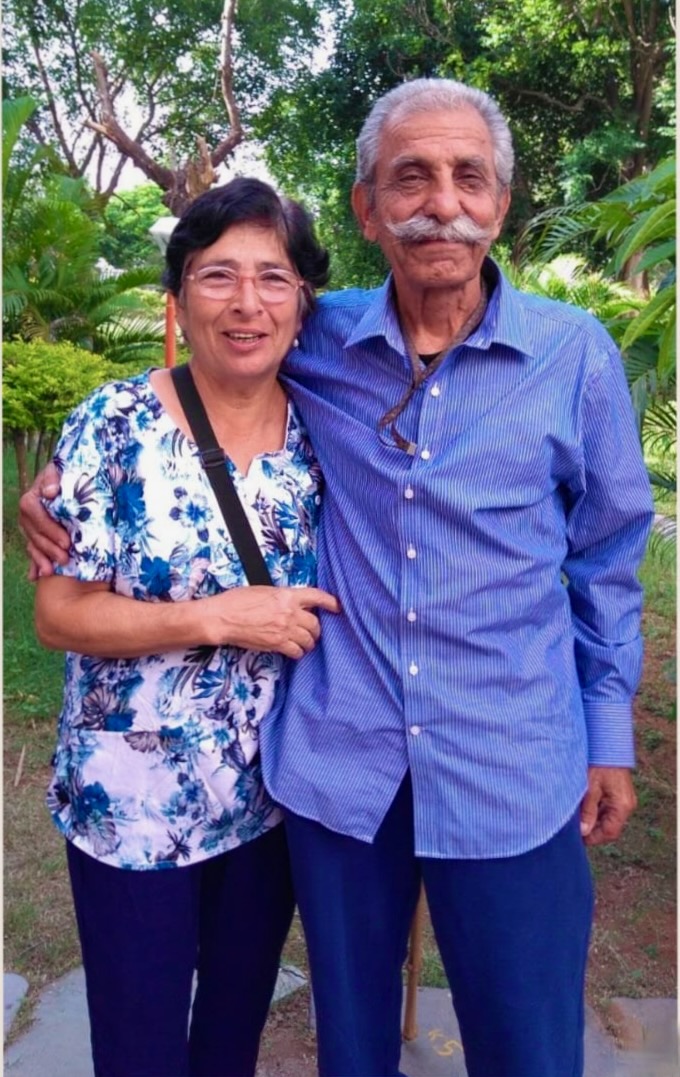
Hamra and Farrage
Faiz Yaganagi
My brother Faiz was born June 4, 1940, in Pune. He received a degree in Mechanical Engineering. He was in Bangalore after finishing his studies, when he met Dr. Muhajir who encouraged him to pioneer to Laos. He obeyed instantly. He is fondly known as “Papa” in Laos. He married a local lady in Laos- Mueng Ma. They have five children – Hooshmand, Aroun, Sengpachan, Anis, and Node. His family have taught the Faith in many provinces in Laos.
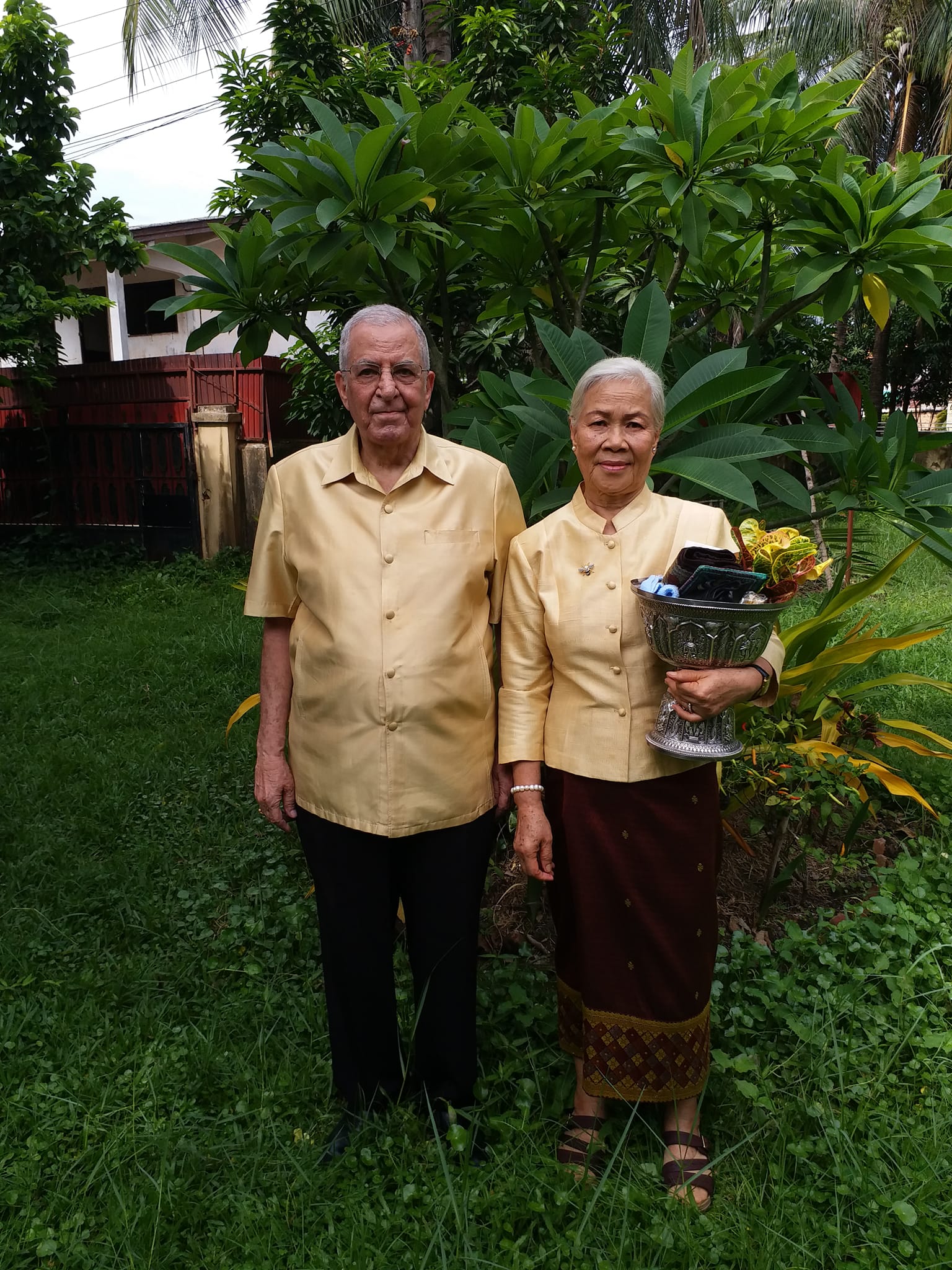
Faiz and Muengma
Tuba Yaganagi Munje
My sister Tuba was born when they lived at the Bahá’í Center on Palm Road on 14 March 1944. She married Mohan Munje in 1964 in New Delhi and then lived in Kanpur until her daughter Tina was one year old. They have two children – Tina and Muhit. With the encouragement of Hand of the Cause of God Dr Muhájir in 1967, her family pioneered to Kathmandu, Nepal for seven years. The first National Spiritual Assembly of Nepal was elected while they lived there.
Again, with advice from Dr. Muhájir, Tuba’s family, pioneered to Calcutta in Bengal for eleven years. Tuba was able to continue her distance education in Sociology, which proved very useful in her Social Action Projects for the Faith. Upon the request of the National Spiritual Assembly of the Bahá’ís of India, the family moved to New Delhi for 11 years as pioneers. Her husband Mohan served as the Manager of the Publishing Trust, while Tuba served on the staff of the Bahá’í House of Worship as the librarian for ten years. She also served two terms as Auxiliary Board member for Delhi and Haryana. Owing to health reasons, they then moved to Bangalore for seven years and served on the Local Spiritual Assembly and the State Bahá’í Council. They then finally pioneered to serve in Gwalior. They volunteered for their service at the Rabbani School. Mohan headed the Moral and Social Activities Department, while Tuba assisted him. Mohan passed away on 3 December 2012 in Gwalior, Madhya Pradesh, India. Tuba continues to live and serve the Faith in Gwalior after the passing of Mohan.
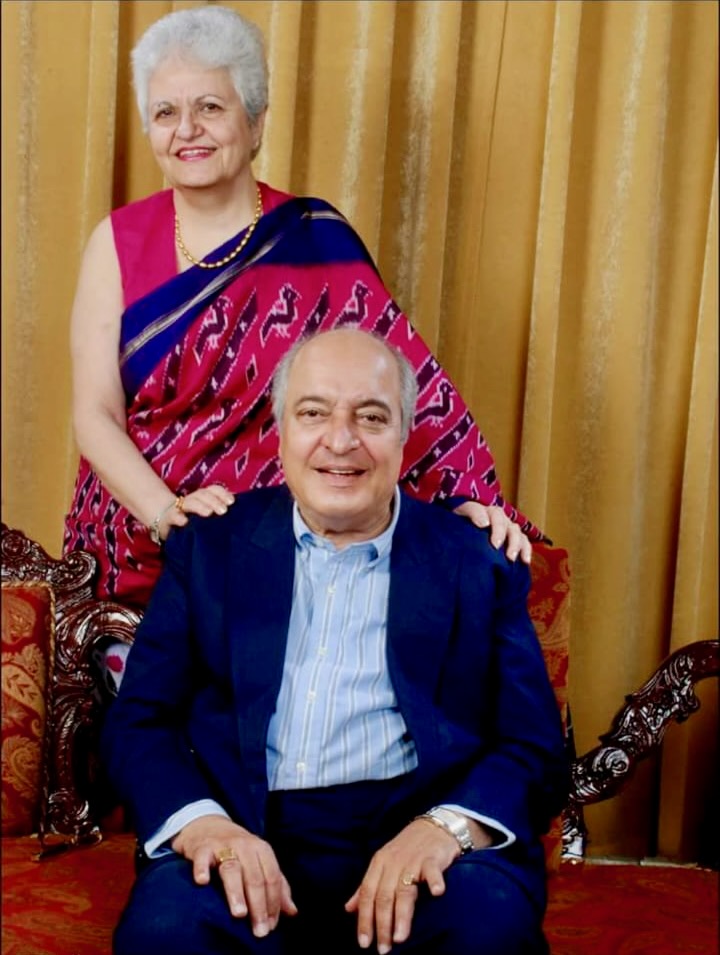
Tuba and Mohan
Qudsiah Yaganagi Sabapathy
My sister Qudsiah was born in Bangalore on September 20, 1947. She had a master’s degree in Sociology. She married Sabapathy Alagiah, who is a pioneer from Malaysia, in 1968. They have three children – Nedah, Nemat, and Nabil.
The family initially pioneered in Laos for a few years, and then moved back to Malaysia. After a few years, they pioneered to Madras in Tamilnadu. The family later pioneered to Mozambique, where Qudsiah served in the Ministry of Education for some years, and then practiced Homeopathy, while Sabapathy worked in Telecommunications.
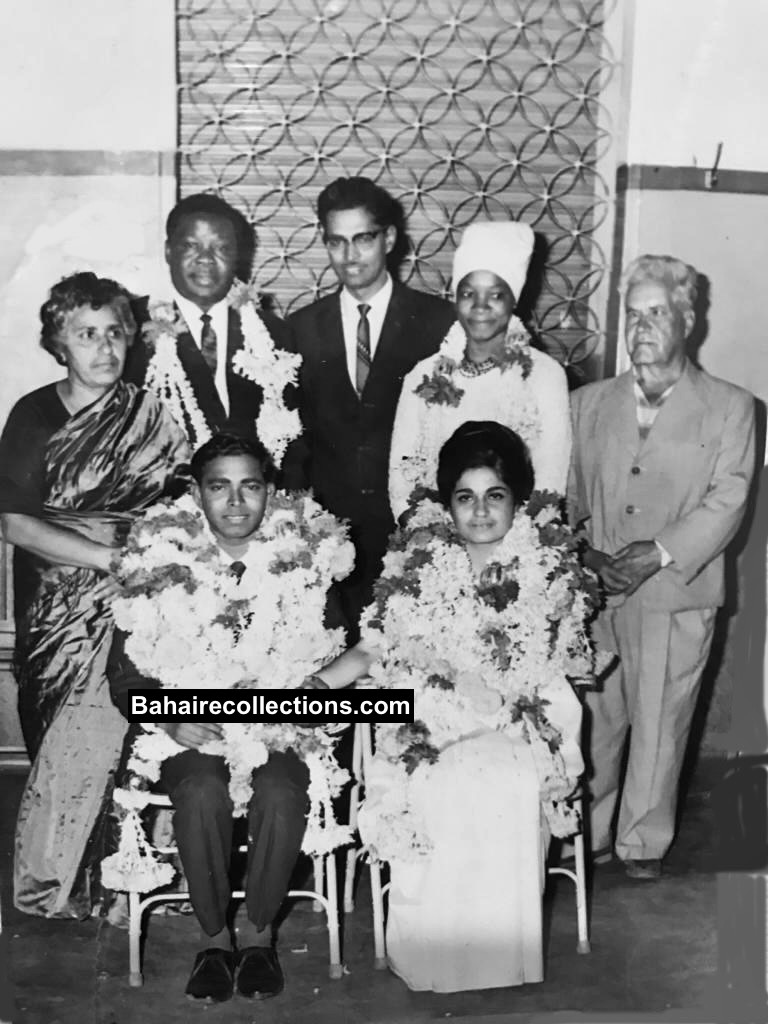
Marriage of Sabapathy and Qudsiah. Standing L-R: My mother Firoozeh, Hand of the Cause Mr.Enoch Olinga, Vasudevan, Mrs. Olinga and my father Soroosh
My own self -Missaghiah Yaganagi
Missaghiah or Mesu, as I am called, was born on 26 November 1949 in Bangalore. In 1972 Dr. Muhajir was visiting my family in Bangalore and asked if I could travel to East Africa to accomplish the remaining unfinished goals of the Nine-Year Plan assigned the National Spiritual Assembly of Tanzania. I gladly accepted and pioneered to Tanzania in 1972 with a group of nine youth from India. While still in the pioneering field, I married Bahman Rowhani in Dar-es-salaam, Tanzania in 1973. In 1974, Bahman and I pioneered to Laos. In 1975, we returned to Iran due to some unusual circumstances, but then pioneered to Sharjah in the United Arab Emirates in 1980. We have two children – Vahid and Anita. In1985, my family relocated to the USA. I have just retired as an educator.
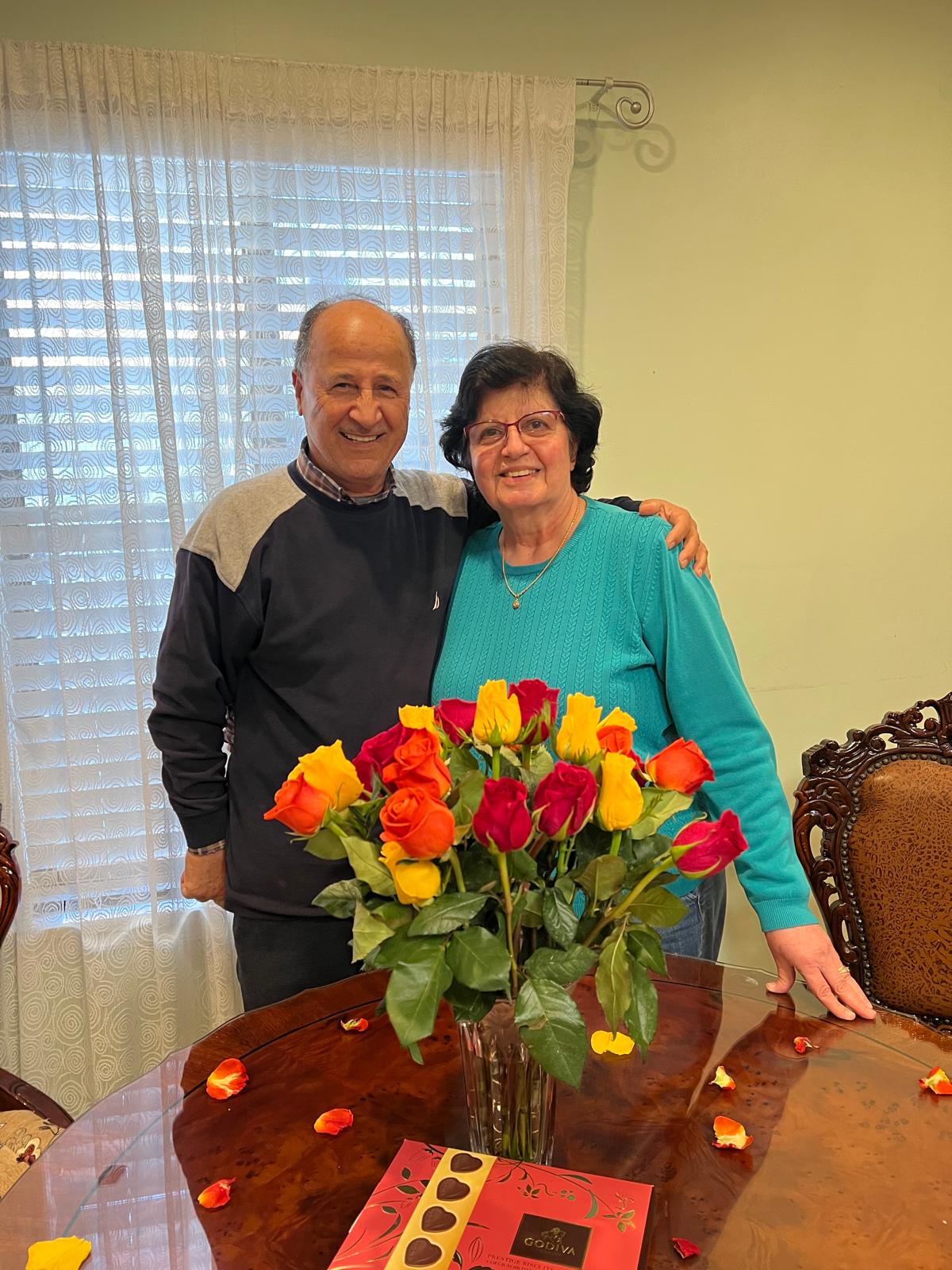
Bahman and Missaghiah
Nazanin Yaganagi Bidenjeri
My sister Nazanin was born 19 May 1953 in Bangalore. She married Adib Bidenjeri. After completing her education, she taught the Bahá’í Faith in South India. They have 3 children – Verity, Shekufeh, and Behin. Her family then pioneered in Dubai, United Arab Emirates, where she presently resides.
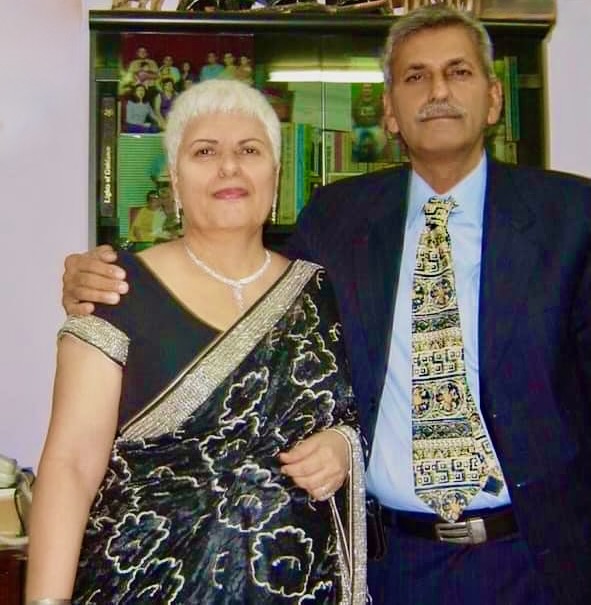
Nazanin and Adib
Attapur Yaganagi
My brother Attapur was born on August 12, 1956. Attapur studied to be an Automobile Engineer in Madras. He married Sheela, and they have 2 children – Carmel and Siddharth. Sheila and Attapur stayed in India for a few years after their marriage, but Dr. Muhájir encouraged them to pioneer to Phuntsholing in Bhutan. He set up a Particle Board factory for the government of Bhutan. Atta returned to Bangalore, where they continued to serve the Faith.
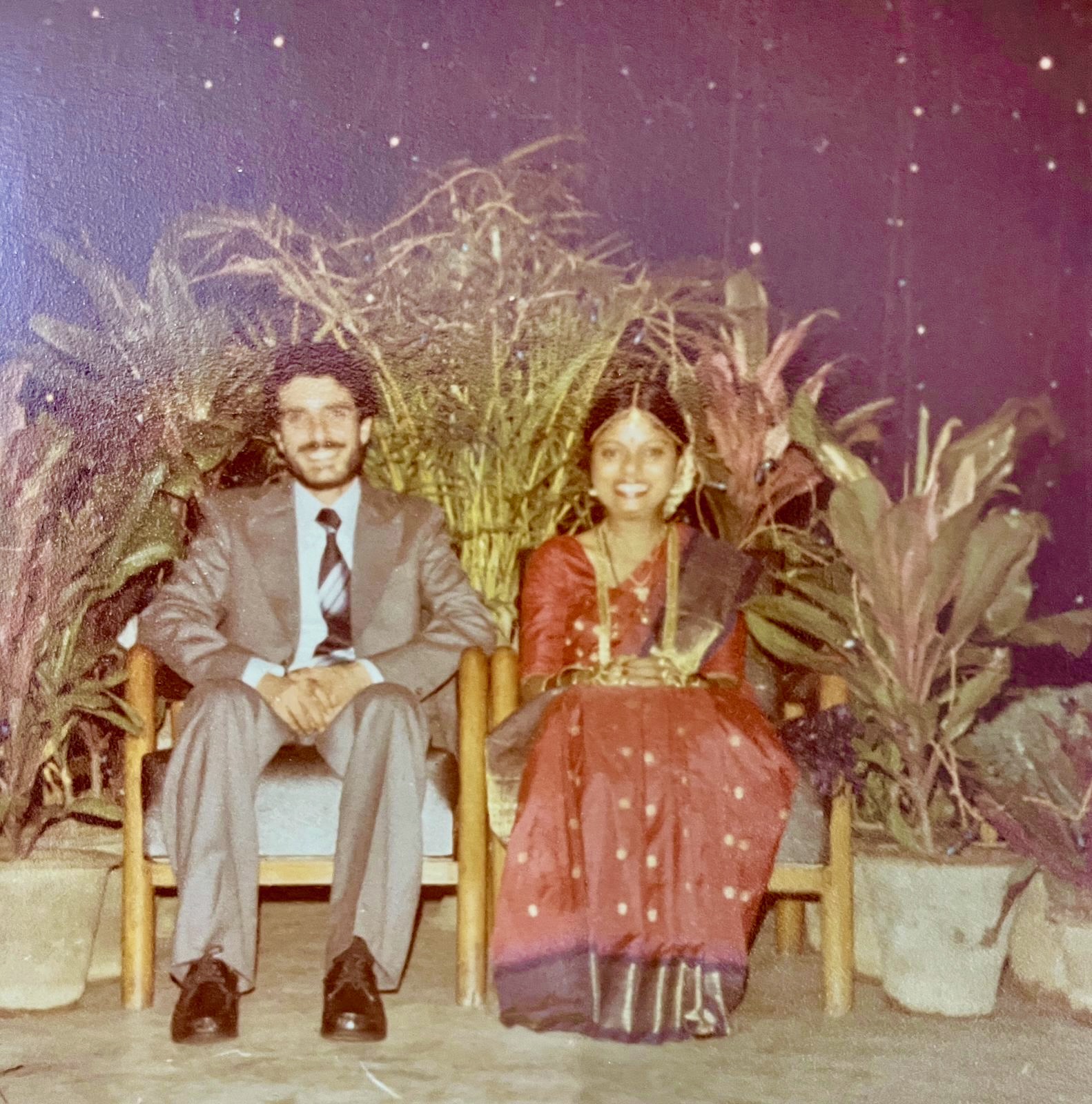
Attapur and Sheela
TRAVELS OF MY PARENTS
My father went on teaching trips to Madhya Pradesh in India, and on an extended trip with Professor Laxminarayan to the states in South India. My parents traveled to visit Anayat, Lingshay and their family in Thimphu, Bhutan. They visited Tuba and Mohan and their family in Kanpur, Delhi and then in Calcutta and Gwalior. They regularly visited Nazanin and Adib and their family in Dubai. They also met me and my husband Bahman and our family in Sharjah. They regularly visited the rest of the family in India. My mother would visit her family who were ill and take care of them for months.
WITH ABIDING GRATITUDE
Both my parents lived a life of sacrifice. They may not have been well-educated owing to the culture in Iran in those days. But they were very mature in their thoughts and wisdom. More than that, they had understood the mission and the spirit of the glorious Faith of Bahá’u’lláh. And they strived to inculcate the Bahá’í values in us. Their first sacrifice was to the beloved Bahá’í Faith, and then to their children.
My mother gave us the greatest encouragement to study daily. Although we grew up in a small village in India, all of us received high level education. My mother was instrumental in getting us admitted into our schools and colleges.
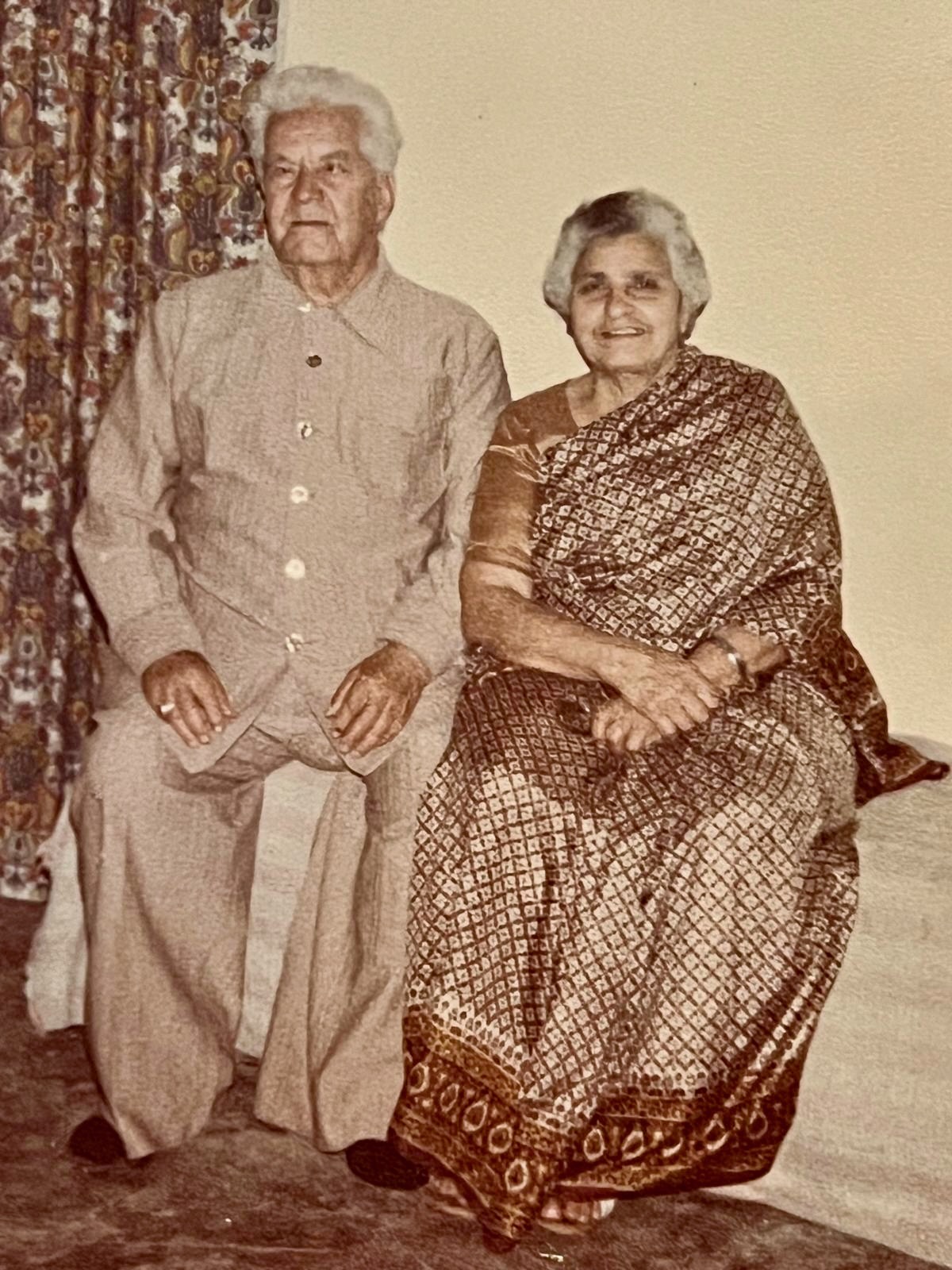 My mother Firoozeh Yaganagi and my father Soroosh Yaganagi
My mother Firoozeh Yaganagi and my father Soroosh Yaganagi
My parents got us involved in the activities of the Faith and social work even at a young age. We carried out service projects on the weekends by teaching at children’s classes at our house and also at the Bahá’í Center in the village. We went to nearby villages to give medical help with Dr. Saroja Vittal, whom we called Dr. Saroja Bai and my eldest brother Dr. Anayat. We also had a medical clinic in our house and my eldest brother Anayat served the community as a doctor. The clinic was free and only those who could pay offered him money. My father came forward and paid for all the medicines whenever the poor could not afford them. My parents provided accommodation for all Bahá’í travel teachers that came to Bangalore, and also for those who passed through this city.
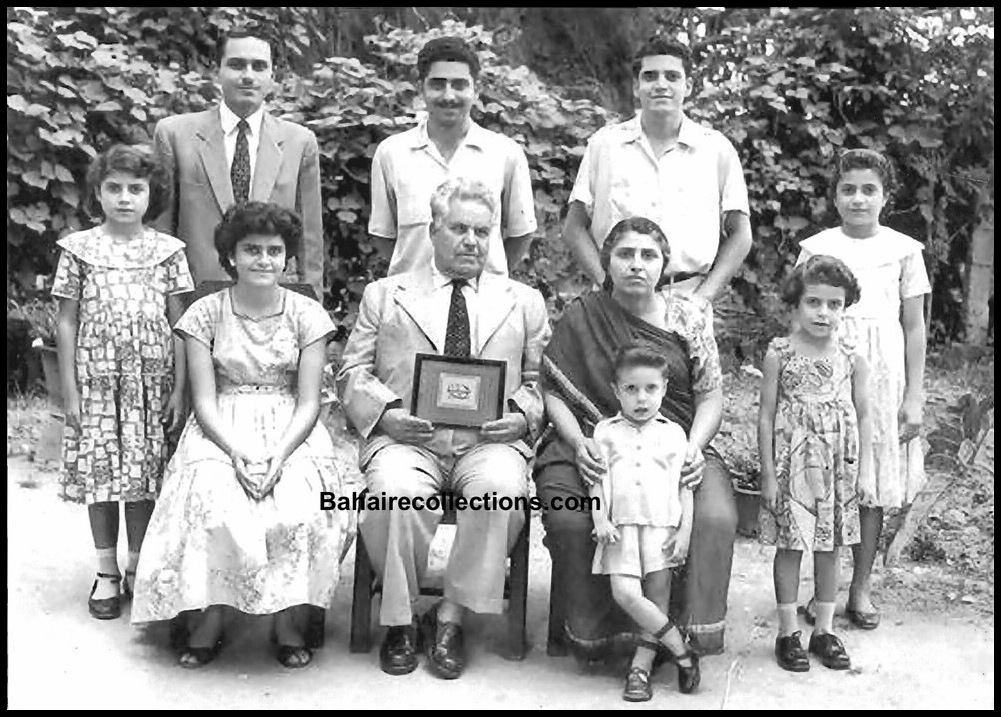
Looking back at 1960: Front row L-R: Missaghiah Yaganagi Rowhani, Tuba Yaganagi, my father Soroosh, my mother Firoozeh, Attapur Yaganagi (in front of my mother Firoozeh) and Nazanin Bidenjeri. Back row L-R: Anayat Yaganagi, Farrage Yaganagi, Faiz Yaganagi , Qudsiah Yaganagi.
My parents never used a foul word nor physically punished us. All their training and discipline were through what the Bahá’í writings taught. Both of them achieved the goals they set for themselves- establishing the Faith on a strong footing in Bangalore and the surrounding areas, bringing up their children the Bahá’í way, and serving the Cause and humanity relentlessly till their last breath. My father passed away in Dubai, United Arab Emirates on 10 April 1991 and my mother passed away in Vientiane, Laos on 27 April 2002.
On learning of the passing of my father, the Universal House of Justice sent this cable dated 10 April 1991 to the National Spiritual Assembly of India:
GRIEVED PASSING SAROOSH YAGANEGI VERY FIRST PIONEER SOUTH INDIA WHO FOR NEARLY HALF A CENTURY PERSEVERED AT HIS POST AND WAS REGARDED SPIRITUAL FATHER BAHAI COMMUNITIES THAT REGION. HIS SELFLESSNESS SINCERITY AND COMMITMENT TO SERVING THE FAITH SET EXAMPLE TO TENS OF THOUSANDS OF BELIEVERS IN SOUTHERN INDIA WHERE HE RAISED THE BANNER OF BAHAULLAH FOR THE FIRST TIME.
ADVISE HOLD MEMORIAL GATHERINGS IN SOUTH INDIAN STATES. ASSURE HIS WIFE, CHILDREN, FRIENDS LOVING PRAYERS HOLY SHRINES BESEECHING PROGRESS HIS RADIANT SOUL ABHA KINGDOM.
UNIVERSAL HOUSE OF JUSTICE
All their thoughts and actions were centered on the needs of the Faith, and they strove not only to teach the Faith through words, but also through the lives they led. When some of my siblings wanted to marry into other races, they gave us their fullest blessings in light of the Bahá’í Teachings. They were pioneers, who brought forth children who all pioneered to some countries at some point in their lives. We all have done well both in the Faith and in financial strength, all with their blessings. Through our marriages we have produced third, and even fourth generations who are all Bahais and serving with distinction in various corners of the globe. It is beyond the scope of my story in covering all those in the next generations. Suffice to say the genesis of our success as believers goes to our good upbringing.
Say, O My people! Show honour to your parents and pay homage to them. This will cause blessings to descend upon you from the clouds of the bounty of your Lord, the Exalted, the Great.” – Bahá’u’lláh.
Missaghiah Yaganagi Rowhani
Culver City
California
USA
30 November 2024
SOURCES
- Shoghi Effendi, Dawn of A New Day
- Shoghi Effendi, Messages to the Indian Subcontinent
- Violette Nakhjavani, Amatu’l-Bahá Visits India
- The Bahá’í World, Volume, 9
- Narratives from our parents, as corroborated with my siblings.
Copyright©bahairecollections.com